

Harvey and Lee Depart the TSBD
by John Armstrong
In the days leading up to the assassination there was almost certainly a careful day by day monitoring of HARVEY Oswald's movements and activities. Those who were in a position to observe him were an unknown operative at the 1026 N. Beckley Avenue rooming house during the week; Ruth Paine and neighbors Bill Willis and William Simmons (who both worked for Jack Ruby) in nearby Irving on the weekends; and Bill Shelley as HARVEY Oswald's likely contact in the TSBD.
During the noon hour on 11/22/63, it was imperative that HARVEY Oswald be isolated, alone in a room within the building, during the passing of the motorcade. The second-floor lunchroom was the perfect location. If HARVEY was seen either outside or inside of the TSBD during the shooting then he would have an alibi, and months of preparation setting him up as the "patsy" would be lost. Another critically important factor was to ensure that HARVEY and LEE would not bump into each another while inside the building or when exiting the building. The plan, therefore, was for the two men to take different routes out of the building. LEE Oswald, who was on the 6th floor impersonating HARVEY Oswald for the last time, would leave the TSBD on the west side, walk across the Elm St. extension, and leave Dealey Plaza in a Nash Rambler station wagon. HARVEY Oswald, while sitting alone in the 2nd floor lunchroom at the time of the shooting, was probably unaware that JFK had been shot. After being confronted by DPD Officer Marrion Baker, at gunpoint, HARVEY was unsure of what to do next and immediately began to look for his contact, Bill Shelley, for advice and direction. Nothing could be left to chance.
As
the Presidential motorcade turned north from Main St. onto Houston St.
some or all of the electrical circuits in the TSBD were temporarily
turned off. After the shooting, the two men on the 6th floor entered
the top of the passenger elevator shaft from the 6th floor, lowered
themselves onto the top of the elevator cabin, and then dropped into
the passenger elevator that was stopped on the 4th floor. The
electricity was then turned back on and the two men, now inside the
passenger elevator, rode from the 4th floor to the 2nd floor. It
appears that LEE Oswald (white t-shirt) got off the passenger elevator
and began walking thru the 2nd floor hallway toward the old wooden
stairway (follow the RED line below). His intention was to walk down
the old wooden stairway to the first floor, where Bill Shelley and
Billy Lovelady were waiting, and then leave the building. However, as
LEE Oswald approached the door that lead into a vestibule that provided
access to both the stairs and the lunchroom he suddenly stopped (see
#27 below). LEE Oswald may have heard commotion and/or noise from
people running up or down the stairs (likely Officer Baker and Roy
Truly). LEE Oswald hesitated, did not open the door into the vestibule,
but instead quickly opened the door immediately to his right (see #28
below) and walked into the TSBD office (follow the GREEN line).
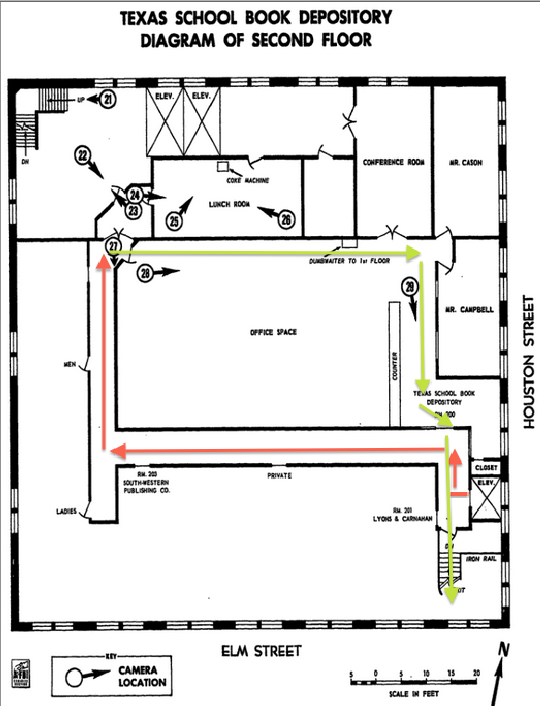
Mrs.
Reid, a TSBD employee, had just returned to her office when she saw
Oswald (LEE) as he began walking into the office from the back door. As
he walked thru the office Mrs. Reid said that he was wearing a white
t-shirt
and carrying a bottle of Coke. Mrs. Reid's testimony caused a great
deal of trouble for the Warren Commission. The Commission knew that
Oswald, when confronted by Officer Baker in the lunchroom, was
wearing a long-sleeve brown shirt. The
Commission said that a minute or two later Oswald walked thru
Mrs. Reid's office wearing a white shirt, then wore a brown
shirt on Cecil McWatters bus, a brown shirt in William
Whaley's taxi, and was wearing a brown shirt when arrested in
the Texas Theater Theater. However, the commission never understood nor
were they ever able to explain how Oswald was able to wear a brown
shirt in the lunch room, wear a white t-shirt in
Mrs. Reid's office, then wear a brown shirt in a bus, in
a taxi, and in the Texas Theater Theater when he was arrested.
Brown shirt/White shirt/Brown shirt
The Warren Commission was never able to resolve this conflict (brown
shirt/white shirt/brown shirt), because they never understood nor
realized there were two "Lee Harvey Oswalds" in the TSBD on 11/22/63.
The man wearing the white t-shirt (LEE Oswald) was on the 6th floor for
the purpose of setting up HARVEY Oswald as the "patsy," who was alone
in the 2nd floor lunchroom during the shooting. When confronted 1 1/2
minutes after the shooting by Officer Baker and Roy Truly, (HARVEY)
Oswald wearing a brown shirt. LEE Oswald, wearing a white t-shirt, rode
the passenger elevator from the 6th to the 2nd floor. He left the
passenger elevator and walked in the hallway toward the northwest
corner of the building (wooden stairs). He entered the TSBD office thru
the rear door (observed by office worker Mrs. Reid), walked thru the
office, and then walked down the stairway at the front of the building
to the first floor lobby. He then walked thru the double doors leading
to the warehouse, turned left, walked thru an overhead door on the west
side of the building, onto the loading dock, and down the stairs to the
railroad tracks (see below). LEE Oswald then walked across the
Elm Street extension, hurried down the grassy knoll, and got into the
Nash Rambler station wagon (seen by Roger Craig, Marvin Robinson, Roy
Cooper, Mrs. Helen Forrest).
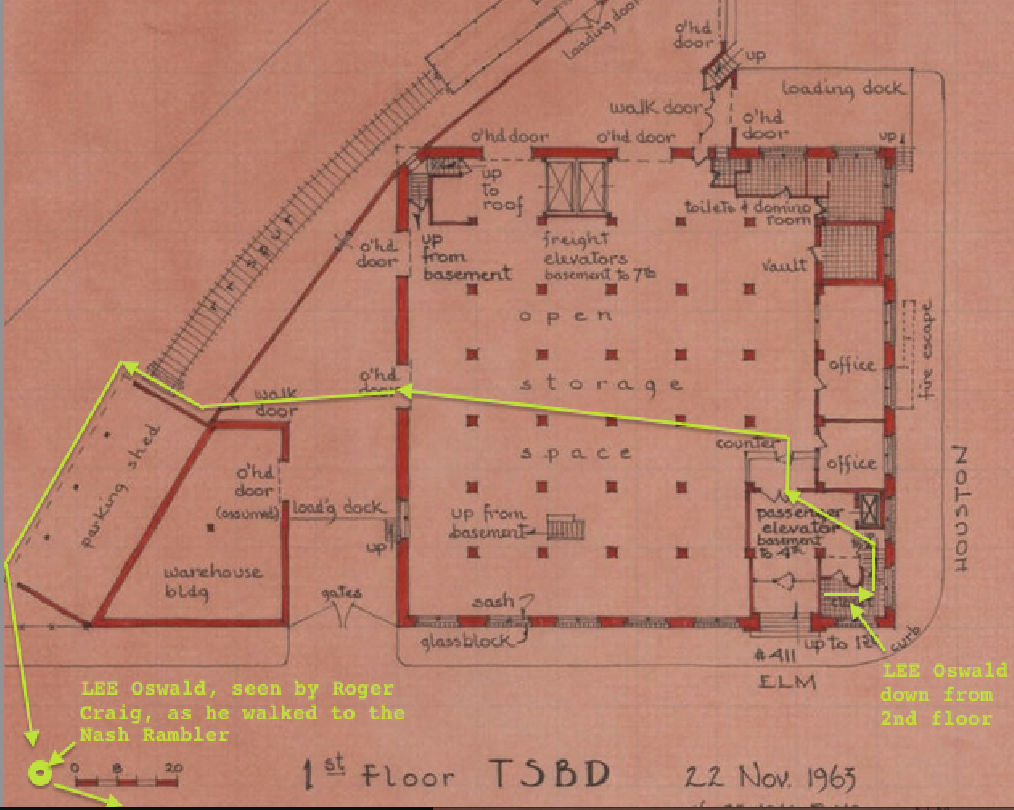
After leaving the TSBD office (circa 12:32-33 PM) LEE Oswald was next
seen on the south side of the Elm Street extension, across the street
from the southwest corner of the TSBD.
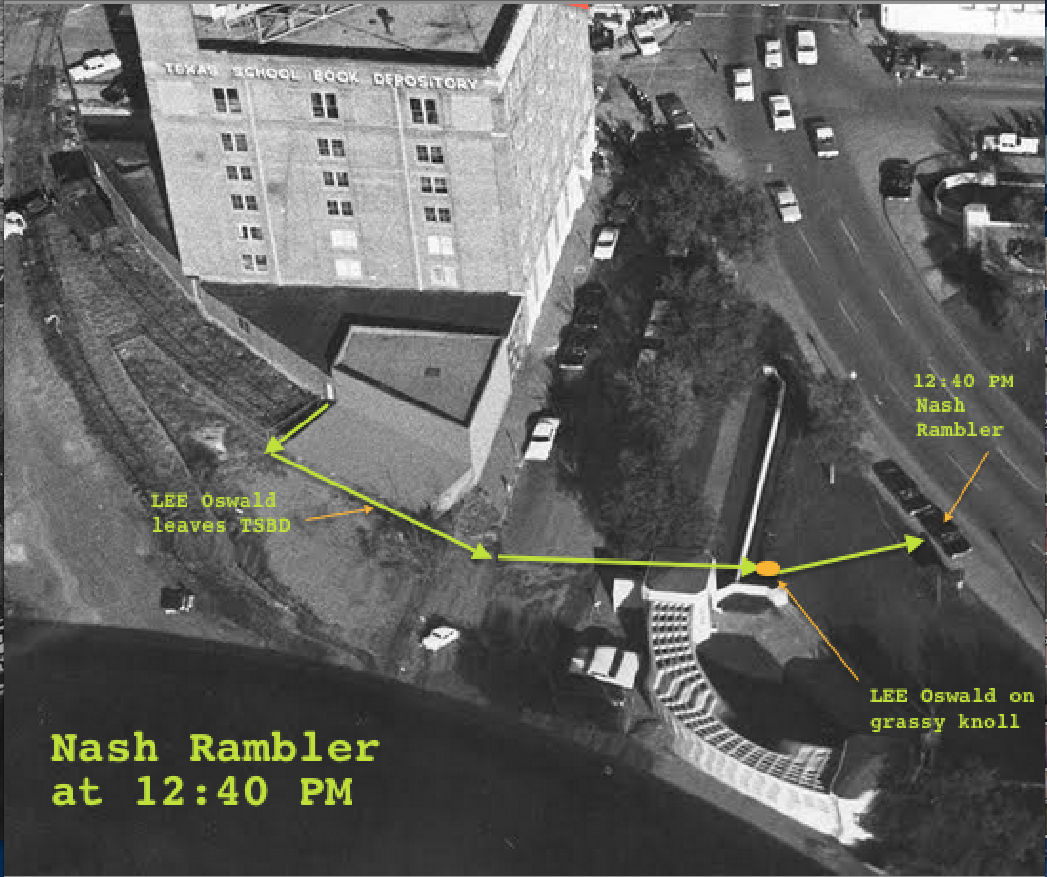
At 12:40 P.M., Deputy Sheriff Roger Craig was standing on the south side of Elm Street when he heard a shrill whistle coming from across the street. He saw a man with sandy brown hair, wearing faded blue trousers and a light colored shirt, hurrying toward the street. A light green Nash Rambler station wagon with a chrome luggage rack, driven by a husky latin man, with short, dark hair, was was moving slowly west on Elm Street. The vehicle suddenly stopped and the man, a white male in his early 20's, wearing a light colored shirt, about 5'9” tall and 140-150 pounds, ran across the lawn that was adjacent to the Elm Street extension and got into the station wagon. Craig was unable to cross Elm Street, due to heavy traffic, and watched as the car drove west on Elm, under the triple underpass, and headed in the direction of Oak Cliff.
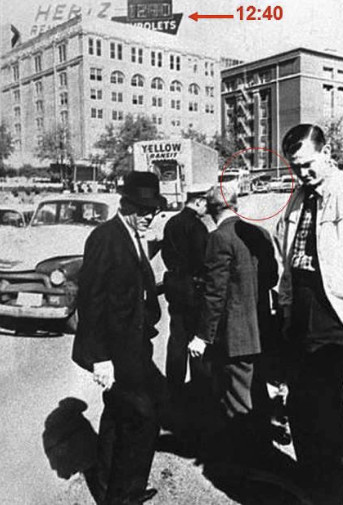 |
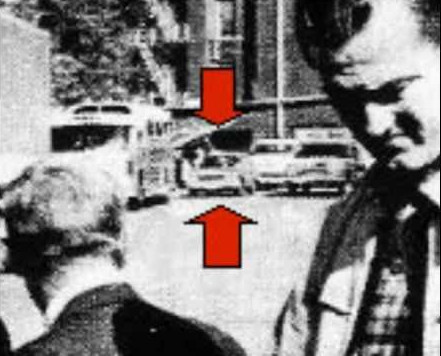 |
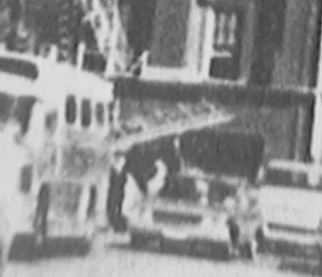 |
NOTE: Two
hours later Roger Craig saw Lee HARVEY Oswald in custody at DPD
headquarters and identified him as the man who left Dealey Plaza in the
Nash Rambler station wagon. But it was LEE Oswald who Craig saw get
into the Nash Rambler--not HARVEY Oswald, who was at 12:40 PM boarding
Cecil McWatters' bus six blocks east on Elm Street.
Marvin Robinson was driving his Cadillac west on Elm Street, directly behind the Nash Rambler station wagon. After crossing Houston he drove past the TSBD and almost slammed into the back of the Nash Rambler when it suddenly stopped. Robinson noticed a white male hurry down the grass covered incline and enter the station wagon. He then followed the car as it drove under the triple overpass.
Marvin Robinson's employee, Roy Cooper, was following him in a different vehicle. Cooper remembered the Nash Rambler stopped so suddenly that Robinson narrowly avoided running into the back of the Nash Rambler station wagon. Cooper saw a white male between 20 and 30 years of age wave at the driver, hurry toward the car, and enter the vehicle.
NOTE: The FBI interviewed Marvin Robinson and Roy Cooper but they never testified before the Warren Commission nor were their statements published in the Warren Volumes.
Mrs. Helen Forrest saw the same young man run from the side of the TSBD and enter a Nash Rambler station wagon on Elm Street. Mrs. Forrest said, "If it wasn't Oswald, it was his identical twin." Mrs. Forrest was the first and only witness in Dealey Plaza to correctly identify the man in the white shirt as "Oswald" or his twin.
Another witness, James Pennington, also saw the same man, in a white shirt, run from the side of the TSBD and enter a Nash Rambler station wagon. Pennington later identified the man as "Lee Harvey Oswald."
These eye-witnesses (Craig, Robinson, Cooper, Forrest, Pennington) saw a man who looked very much like the Lee HARVEY Oswald who was arrested by Dallas police. But, it was NOT the same man. It was NOT the Oswald who was shot and killed by Jack Ruby. These witnesses saw LEE Oswald, the man who had been impersonating HARVEY Oswald and setting him as the “patsy” for the assassination for the past three months.
Photographer Jim Murray took a picture of the crowd standing in front of the TSBD, and also captured the Hertz sign on the top of the TSBD which read 12:40 pm. Murray's photo shows a man standing on the south of Elm Street, wearing a light-colored shirt, and looking at the light colored Nash Rambler station wagon. Deputy Sheriff Roger Craig can be seen standing on the east side of Elm Street, observing the man as he approaches the car.
Fifteen
to twenty minutes later (a few minutes before 1:00 PM) LEE Oswald was
seen walking west, past the 10th St. Barber Shop near 10th and Ewing
(he was en route to a pre-arranged meeting at 1:00 PM with Capt.
Westbrook and Officer J.D. Tippit near 10th & Patton). Minutes
later LEE Oswald was seen by several people walking west near 10th
& Denver St (one block east of 10th & Patton), wearing a white
Eisenhower-type jacket, and carrying a .38 revolver. Where and how did
LEE Oswald acquire the jacket, and the gun he used to kill Officer
Tippit? It is possible, and even likely, that both the jacket and the
gun were given to him by the driver of the Rambler that picked up LEE
Oswald in Dealey Plaza and drove him to Oak Cliff? Deputy Sheriff Roger
Craig described the jacket worn by the driver of the Rambler, which the
driver may have given to LEE Oswald after they arrived in Oak Cliff.
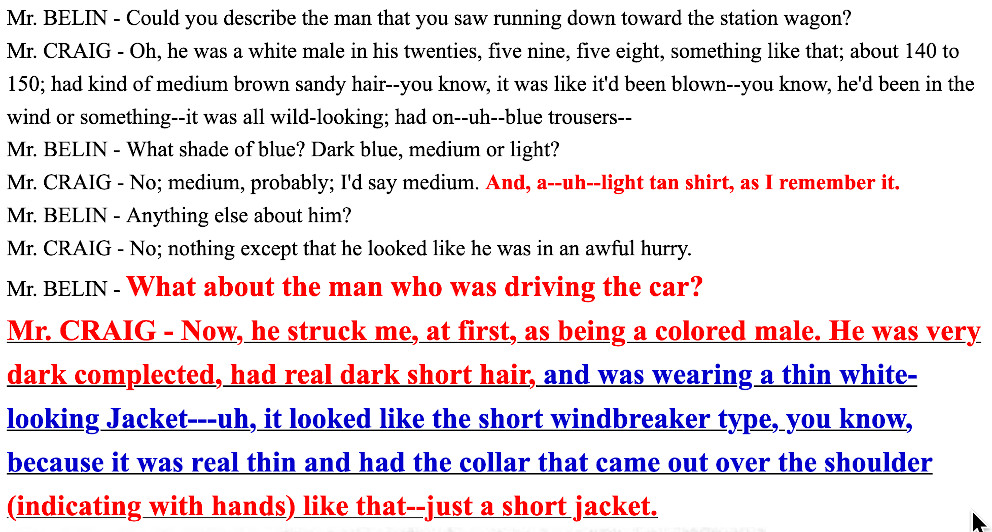
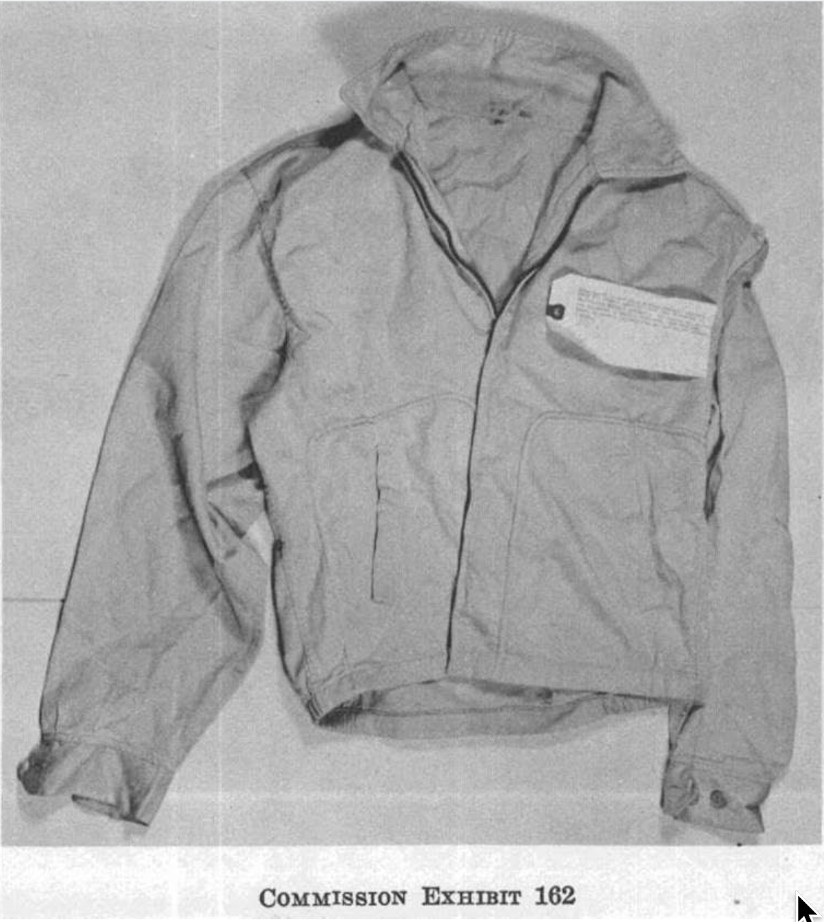
NOTE: as LEE Oswald met up with Officer Tippit (1:06 PM) and began talking with him thru the passenger side car window of the patrol car, HARVEY Oswald was already inside the Texas Theater wearing only a dark brown long sleeve shirt.
WFAA
(Dallas) radio program director Pierce Allman was leaving his office en
route to Dealey Plaza when he encountered WFAA salesman Terrance
(Terry) Ford. Allman asked Ford if he would like to go with him to see
the Presidential motorcade, and both men began walking north on Houston
St., four blocks to Dealey Plaza. Both men were standing at the corner
of Elm and Houston, directly across the street from the TSBD, as the
President's car passed directly in front of them. After the 3rd shot
was fired at President Kennedy, Allman ran to the grassy knoll area,
where he saw and spoke briefly with Bill Newman. He quickly
realized that he needed to call the WFAA news room, and then ran to the
TSBD hoping to find a telephone. Mr. Allman entered the TSBD at 12:33
PM.
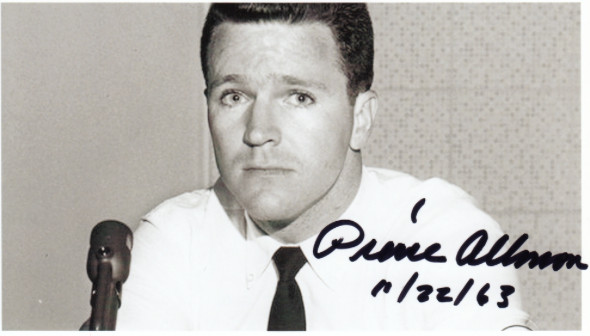
Pierce
Allman, WITH crew cut
NBC news correspondent Robert MacNeil (New York City) was in the press bus, in the motorcade, when he heard the shots. He quickly left the bus, ran up the grassy knoll, climbed over the wooden fence, and began to look around the railroad yard but saw nothing. He realized that he needed to call NBC in New York, and ran to the nearest building to look for a telephone. MacNeil said that he arrived at the TSBD at 12:34 PM, four minutes after the shooting.
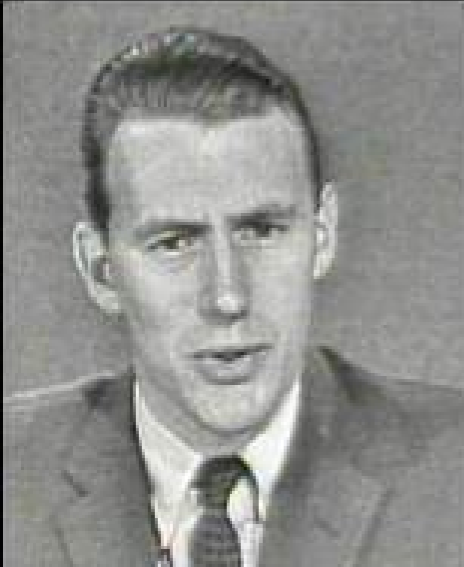
Robert
MacNeil, blond hair with NO crew cut
HARVEY Oswald
After HARVEY
Oswald was confronted by DPD officer Marrion Baker and Roy Truly in the
2nd floor lunchroom (circa 12:32 PM), it appears that (HARVEY) Oswald
left the 2nd floor lunchroom and took the stairs at the front of the
building to the first floor lobby (see photo below). (HARVEY)
Oswald now knew that something had happened in the Presidential
motorcade, and needed to locate his supervisor/contact (Bill Shelley)
to ask for instructions and/or direction. HARVEY Oswald likely walked a
few steps to the main entrance of the TSBD and looked thru the glass
doors to see if he could locate Shelley. It is doubtful that
HARVEY Oswald would have left the building, in the middle of a workday,
without first checking in with his supervisor/contact (Shelley) and
asking for instructions and/or direction.
NOTE: At this moment Shelley and Billy Lovelady were at the back of the building, where they were seen by Vickie Adams standing near the wooden stairway.
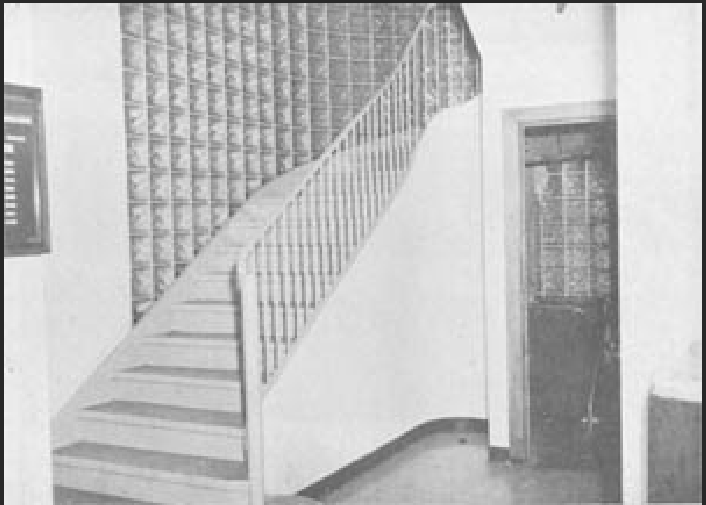 |
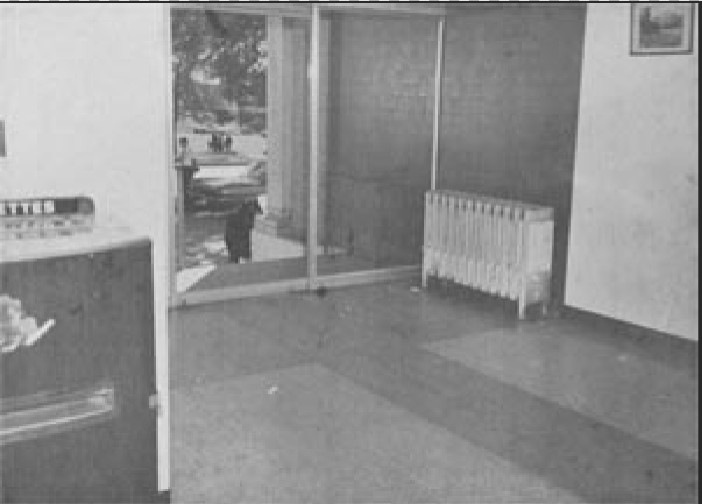 |
| Front stairway from the
1st floor to 2nd floor |
Lobby inside the TSBD,
facing south on the Elm St. extension |
At 12:33 PM (HARVEY) Oswald
was standing in the lobby inside the front door when WFAA radio program
director
Pierce Allman and WFAA salesman Terrance (Terry) Ford entered the
building and hurriedly asked for the location of a telephone. Pierce
Allman said, "this young man [Oswald] was totally calm. How do you do
that [kill the President] and stay so calm? He was not in a hurry. Not
breathless. Appeared normal." CLICK HERE for Pierce Allman interview
(starts at 1:28). The young man (HARVEY Oswald) directed Allman to a
pay
phone in the lobby (on the wall, left side of passenger elevator).
HARVEY Oswald then walked thru the double doors and into the warehouse
area.
NOTE: When interrogated by DPD Capt. Fritz, Oswald said that as he was preparing to leave the building a man with a crew cut appeared (Allman had a crew cut; NBC news correspondent Robert MacNeil had long, blond hair), showed what he believed to be Secret Service identification, and asked for the location of a telephone. Two weeks after the assassination the US Secret Service interviewed Pierce Allman and asked if he could describe the person who directed him to the telephone. Allman was unable to recall any descriptive information whatsoever about this person.
After entering the warehouse, it appears that (HARVEY) Oswald finally located Bill Shelley and began talking with Shelley and Billy Lovelady in front of Shelley's office. Shelley, Lovelady, and Oswald (HARVEY) were almost surely the three men seen by NBC news correspondent Robert MacNeil when he arrived at the TSBD and entered the warehouse a minute later.
NOTE: We must remember that both Shelley and Lovelady were seen together two minutes earlier near the stairway and freight elevators on the first floor at 12:31 PM by Victoria Adams, and were seen together a minute later by Officer Baker and Roy Truly at 12:32 PM (identified as 2 "white men" by Baker).
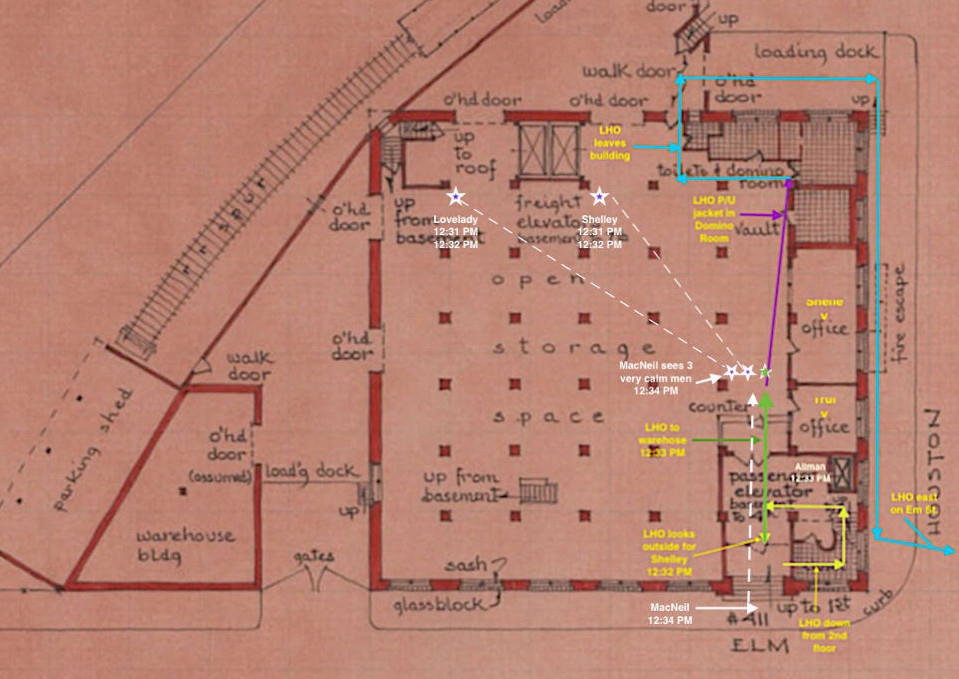
As
the 3 men (Shelley, Lovelady, Oswald) were talking near Shelley's
office in the warehouse, NBC news correspondent Robert MacNeil entered
the lobby of the TSBD (12:34 PM), encountered a young man with
rolled-up shirt sleeves near the entry door, and asked for directions
to a telephone. The young man pointed to the double doors and MacNeil
then hurried thru the double doors and "into the clear space"
[warehouse area] on the ground floor." From all indications and
available evidence, the young man encountered by MacNeil in the lobby
was NOT (HARVEY) Oswald.
NOTE: After reviewing notes taken during (HARVEY) Oswald's interrogation, author William Manchester (Death of a President) realized that (HARVEY) Oswald had directed an unknown person, likely a news reporter, to a telephone in the lobby of the TSBD only minutes after the shooting. Notes taken by Capt Fritz and SS agents show that the man (HARVEY) Oswald encountered in the lobby of the TSBD had a crew cut and displayed what he thought were Secret Service credentials. Manchester knew that MacNeil had telephoned his office in New York from the TSBD minutes after the shooting. Two years later, in 1965, Manchester told MacNeil for the first time that it was (HARVEY) Oswald who had directed him to a telephone in the TSBD. MacNeil, however, was not convinced. When asked to describe the young man MacNeil said "the young man was at the front door, shirt sleeves rolled up," and could not give a further description of this person. Both the SS and Capt. Fritz's notes show only that Oswald said the man he encountered in the TSBD lobby had a crew cut, but MacNeil had long hair--not a crew cut. And nothing was recorded in notes taken during interrogation about this man having "blond" hair. It was now obvious that Manchester had misinterpreted and/or misunderstood the notes by Capt. Fritz and the SS and had then given incorrect information to MacNeil. Nevertheless, Manchester was convinced the person described by (HARVEY) Oswald in the lobby of the TSBD was MacNeil, and included this erroneous information in his book, Death of a President. (HARVEY) Oswald did speak briefly with someone in the lobby of the TSBD minutes after the shooting. That person was Dallas WFAA news director Pierce Allman, who arrived at 12:33 PM. Allman had a crew cut, and displayed press credentials to the young man who directed him to a pay telephone in the lobby. A minute later Robert MacNeil entered the TSBD lobby (12:34 PM) and was directed to a telephone in the warehouse area by an unknown young man "with his shirt sleeves rolled up" (possibly Pierce Allman or Terrance Ford).
On
the other side of the double doors, near the counter in the warehouse
area, McNeil immediately encountered three men who he said were all
"exceedingly calm and relaxed." McNeil recalled, "three men there, all
I think in shirt sleeves [without a jacket]." CLICK HERE for Robert MacNeil
interview (starts at 9:10). Oswald was wearing a
brown colored shirt or one similar to it (see left photo below),
Shelley was likely wearing a white shirt (see middle photo
below-11/23/63), and Billy Lovelady was wearing a shirt (see right
photo, below).
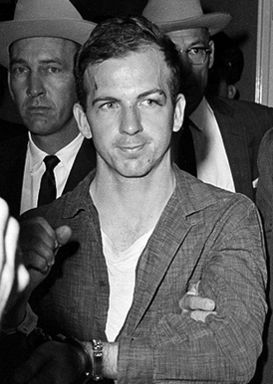 |
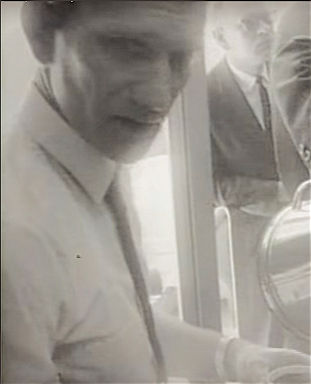 |
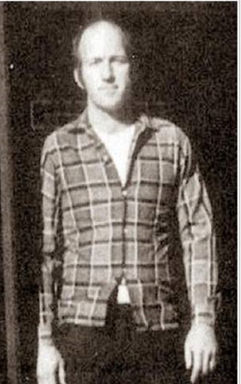 |
REMEMBER: At 12:31 PM Vickie Adams told the W.C. that she saw Bill Shelley and Billy Lovelady at the back of the TSBD on the first floor. At 12:32 PM Roy Truly and DPD Officer Marrion Baker saw two unknown "white men" at the back of the TSBD on the first floor. At 12:33 PM Pierce Allman spoke briefly with (HARVEY) Oswald in the TSBD lobby and described him as "totally calm." One minute later, at 12:34 PM, NBC news correspondent Robert McNeal encountered three "exceedingly calm and relaxed" people. One of those people was (HARVEY Oswald, who Pierce Allman described as "totally calm" when he saw him in the lobby a minute earlier. The other two "exceedingly calm and relaxed men" were likely Shelley and Lovelady. All but two of the TSBD employees who worked in the 1st floor warehouse were laborers. The two "supervisory" employees were Roy Truly and Bill Shelley, and both men had their own office. When MacNeil saw the three "calm men" in the warehouse, 4 minutes after the shooting, Roy Truly was on the 7th floor of the building with DPD officer Marrion Baker. Within an hour of the shooting both Shelley and Lovelady told the DPD (affidavits) that they returned inside of the building immediately after the shooting. If these 3 men were not Shelley, Lovelady, and (HARVEY) Oswald, then who were they?
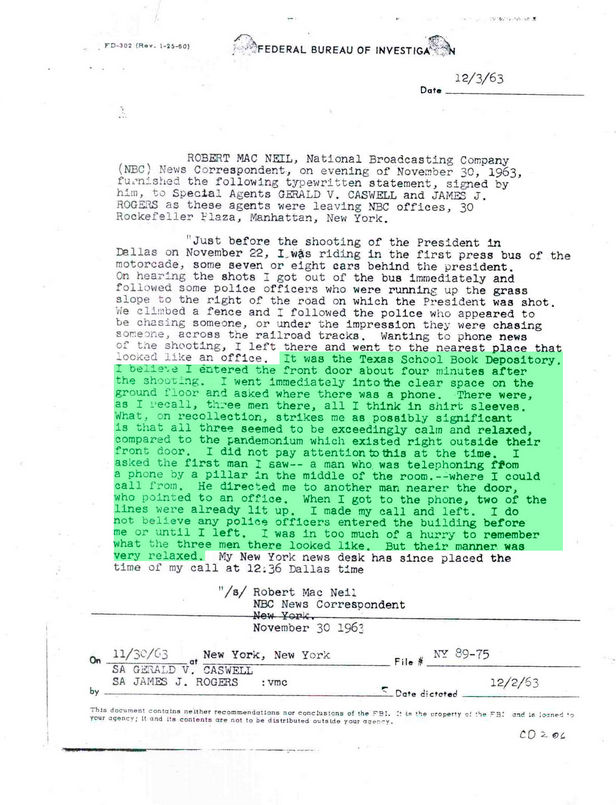
HARVEY Oswald was almost certainly sitting in the 2nd floor lunchroom before, during, and after the shooting. When confronted at gunpoint by Officer Baker, Oswald knew something had happened in the Presidential motorcade. If (HARVEY) Oswald was merely an employee, he would not have left the building without the approval of his supervisor. Had Oswald been given permission to leave the building, he would have taken the Beckley St. bus to his rooming house. Instead, (HARVEY Oswald) hurried down to the first floor lobby, looked outside thru the glass entry doors to locate Bill Shelley, and then went to the warehouse area where he found Shelley and asked for advice and further instruction. Shelley, who I believe was a co-conspirator, knew that it was very important to get Oswald out of the building as soon as possible, in order to make it appear as though he was "running from the police." Someone, within 4 minutes of the shooting, gave Oswald instructions to leave the TSBD, board the Marsalis bus #433, and immediately proceed to the Texas Theater in Oak Cliff. If Shelley did not give these instructions to (HARVEY) Oswald, then who did?
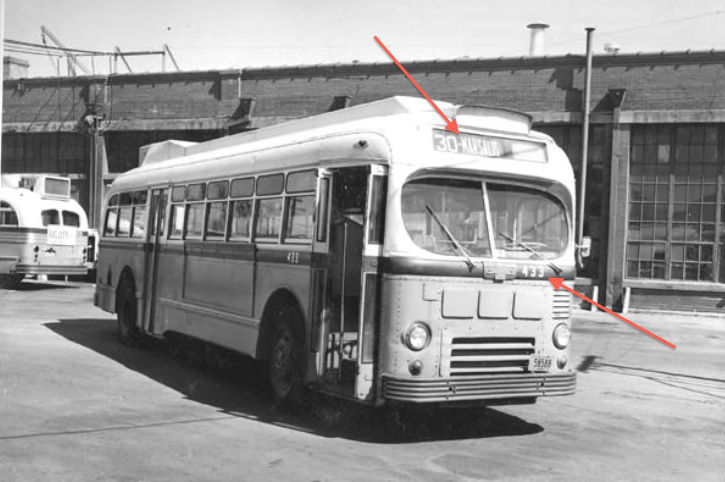
MARSALIS
AVE BUS, #433, ON ROUTE #1213 TO OAK CLIFF
The conspirators knew that
following the shooting of President Kennedy, HARVEY Oswald had to
quickly leave the TSBD in order to make it appear that he was "running
from the police." After being confronted by Officer Baker (HARVEY)
Oswald left the lunchroom and walked down the stairs at the front of
the TSBD. He then entered the warehouse and likely met up with Shelley
and Lovelady. (HARVEY) Oswald was told, most likely by Bill Shelley, to
ride the Marsalis Ave. bus (#433) to Oak Cliff, where he would then
deboard the bus across the street from the GLOCO Station, be picked up
by a Dallas Police officer (J. D. Tippit, who was in the GLOCO parking
lot), and driven to the Texas Theater. Someone, probably Shelley, gave
Oswald one half of two different one dollar bills, and likely gave him
instructions to give one of the dollar bills to the police officer
(Tippit) and the other dollar bill to a contact in the Texas Theater.
Both the police officer and the contact in the Texas Theater would then
be able to confirm Oswald's identity with the other half of the dollar
bill (matching serial numbers). HARVEY Oswald then walked to the domino
room, picked up his light blue/grey jacket, walked out the back
of the
TSBD onto the loading dock (perhaps accompanied by Shelley), walked
down the steps on the east side of the building (on Houston Street),
and began walking toward Elm St.
(HARVEY) Oswald, wearing a white
t-shirt, long
sleeved brown shirt,
light grey work pants, and carrying his light blue/grey
jacket, began walking south on Houston Street. Wesley Frazier, who
said
that he was talking with some women a few minutes after the shooting at
the corner of Elm and Houston, saw Oswald as he walked south on Houston
St. Frazier says that he saw Oswald cross Houston St., begin walking
east on Elm St., and disappeared into the crowd. CLICK HERE for
Wesley Frazier interview (starts at 33:00).
NOTE: Frazier, when interviewed by the Dallas Police and the Warren Commission, said nothing about seeing Oswald walking south on Houston Street minutes after the shooting. Thirty-nine years later, during an interview with 6th Floor Museum Curator Gary Mack (6/21/02), Frazier said that while talking with a few women in front of the TSBD he saw Oswald walking south on Houston St., cross Houston St., walk east on Elm St. and disappear into the crowd. Frazier may or may not be telling the truth, but he is the only person who claims to have seen (HARVEY) Oswald leave the TSBD and leave the scene of the shooting.
Normally, Oswald would take the Beckley bus to his rooming
house on North Beckley, where there was a bus stop nearby. Both the
Beckley and the Marsalis bus arrived on Elm Street at nearly the same
time. But on November 22, Oswald didn't take the Beckley bus. He took
the Marsalis bus driven by Cecil McWatters, apparently for the first
time. But why? The answer is simple.... (HARVEY) Oswald was
following orders. He was told, likely by Bill Shelley, to board the
Marsalis Ave bus (#433), and he followed instructions. However, unknown
to (HARVEY) Oswald, police officers would soon board this bus, search
passengers for weapons, and may have been following a pre-planned and
fatal confrontation with (HARVEY) Oswald.
NOTE:
Every day, for the past 5
weeks, Oswald had ridden the Beckley bus to a stop near his
rooming house. If Oswald had ridden the Beckley bus on 11/22/63, then
the bus driver would likely have recognized him as a regular
passenger. One or more passengers would also have seen Oswald on the
bus. The next day, after Oswald's name and photo became known
world-wide, anyone who saw LHO on the Beckley bus would have
instantly called the police. But nobody called, because Harvey Oswald
was on the Marsalis Ave. bus instead of the Beckley bus.
McWatters was driving the “Marsalis-Ramona-Elwood (bus #433, run #1213) bus west on Elm Street. At 12:36 PM he arrived at St. Paul and Elm on schedule, with his time checked by the company dispatcher. Mary Bledsoe boarded the bus and took a seat across the aisle from McWatters, facing him, as he continued driving the bus west on Elm toward the TSBD.
About 12:40 PM (HARVEY) Oswald, walking east on Elm St., boarded the bus in the middle of an intersection instead of at a regular bus stop. McWatters recalled, “I come to a complete stop [in the middle of the street] and when I did, someone come up and beat on the door of the bus, and that is about even with Griffin St....He paid 23 cents for bus fare.” Oswald walked past Mary Bledsoe, his former landlady, and took the third chair back on the right. McWatters told the WC “he was wearing work clothes, and some type of jacket.”
NOTE: At 12:40, as (HARVEY) Oswald was boarding McWatters' bus, LEE Oswald was six blocks west, walking down the grassy knoll in front of the Texas School Book Depository and was seen by Deputy Sheriff Roger Craig and 4 witnesses as he got into into a Nash Rambler station wagon.
Bus passenger Roy Milton Jones, then 17 years old, remembered that a woman followed [(HARVEY) Oswald] onto the bus when he boarded in the middle of the intersection. Jones said, “A blond woman and a dark haired man (Oswald) boarded the bus approximately six blocks before Houston Street. The man sat in the seat behind him (behind Jones) and the woman occupied a seat further to the rear of the bus.” Jones told the FBI the man sitting behind him wore a “light blue jacket and grey khaki trousers.” Jones, who casually observed this nondescript bus passenger for a brief few minutes, should be commended for remembering anything at all about this man.
 |
 |
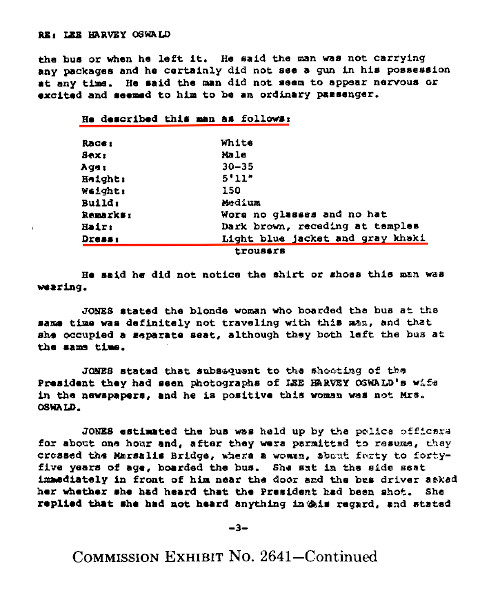 |
NOTE: In the author's opinion it was critical that (HARVEY) Oswald, after allegedly "shooting" the President of the United States, be followed until he was either shot and killed by police or arrested. Nothing could be left to chance, and the author believes the blond woman, who followed (HARVEY) Oswald ino the bus, was following Oswald.
Bus passenger Mary Bledsoe was (HARVEY) Oswald's landlady in Oak Cliff, from October 7 to October 14. (HARVEY) Oswald rented 1 of 3 rooms in her home and she saw him every day. Bledsoe remembered that he constantly used the telephone, in an attempt to find work, which interrupted her naps in the afternoon. After 5 days she told (HARVEY) Oswald that she “was not going to rent to him any more.... I didn't like his attitude.... I didn't like him.... Just didn't want him around me.” Even though Mrs. Bledsoe was 67 years old, divorced, and had recently suffered a stroke, her memory of events concerning (HARVEY) Oswald seems very clear.
NOTE: Before her WC testimony Bledsoe prepared notes, at the suggestion of SS Agent Forrest Sorrels, in order to refresh her memory. Reading from notes to refresh a witnesses testimony is, as any lawyer knows, not uncommon in courtroom proceedings. It is allowed in all state and federal court proceedings (Federal Rules of Evidence --- Rule 612 and Rule 803-S).
On 11/22/63 Mrs. Bledsoe saw (HARVEY) Oswald get on McWatters bus, and discussed her experience with WC attorney Joseph Ball.
Mrs. Bledsoe. “After we to past Akard, at Murphy....Oswald got on....He looks like a maniac. His sleeve was out here. His shirt was undone....Was a hole in it, hole, and he was dirty, and I didn't look at him.” while Bledsoe said he was wearing “a brown shirt with holes in the elbows” and “ragged grey work pants.”
Mr. Ball. Where did he sit?
Mrs. Bledsoe. He sat about half way back down....On the same side I was on....He had on a brown shirt....Hole in the sleeve right here.
Mr. Ball. Which elbow of the sleeve.
Mrs. Bledsoe. Right....Yes, all of the buttons torn off.
Mr. Ball. Was the shirt tucked beneath the belt in his pants, or outside the belt?
Mrs. Bledsoe. No. It was tucked in.
NOTE:
at this point Mr. Ball
had not yet shown CE 150 (the shirt Oswald was wearing when arrested)
to Mrs. Bledsoe. (HARVEY) Oswald's shirt (below), when tucked in below
the belt, would look like all of the buttons were “torn off.” This
shirt also had a hole in the sleeve at the right elbow. If Mrs.
Bledsoe's memory was correct, then the shirt she saw (HARVEY) Oswald
wearing on the bus is the same shirt he was wearing when arrested at
the Texas Theater—dark brown long-sleeve, buttons above the belt
missing, hole in the right sleeve near the elbow.
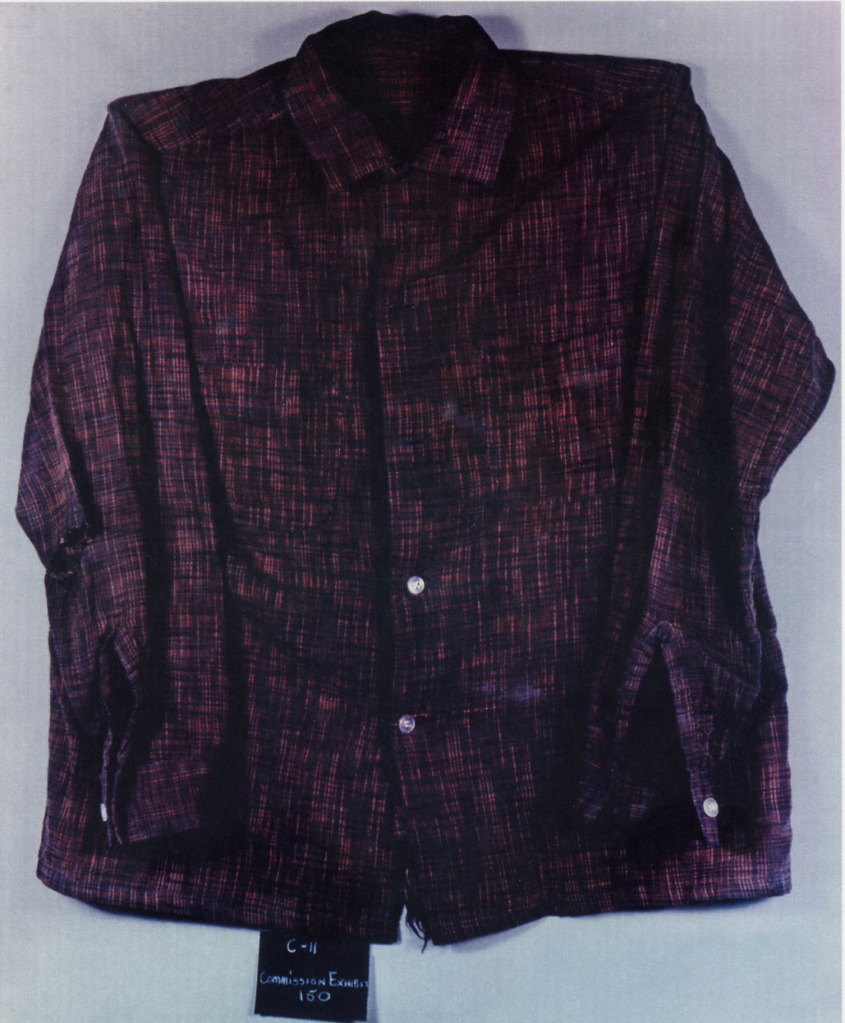
Mrs. Bledsoe (and Roy Milton Jones) said the man she saw on McWatters' bus was wearing grey pants. (HARVEY) Oswald changed his grey pants to a pair of very dark (black) pants in his room, prior to going to the Texas Theater. When arrested (HARVEY) Oswald was wearing very dark pants. Bledsoe (and Roy Milton Jones) could only have known (HARVEY) Oswald was wearing “grey pants” if she (they) had personally seen him on the bus.
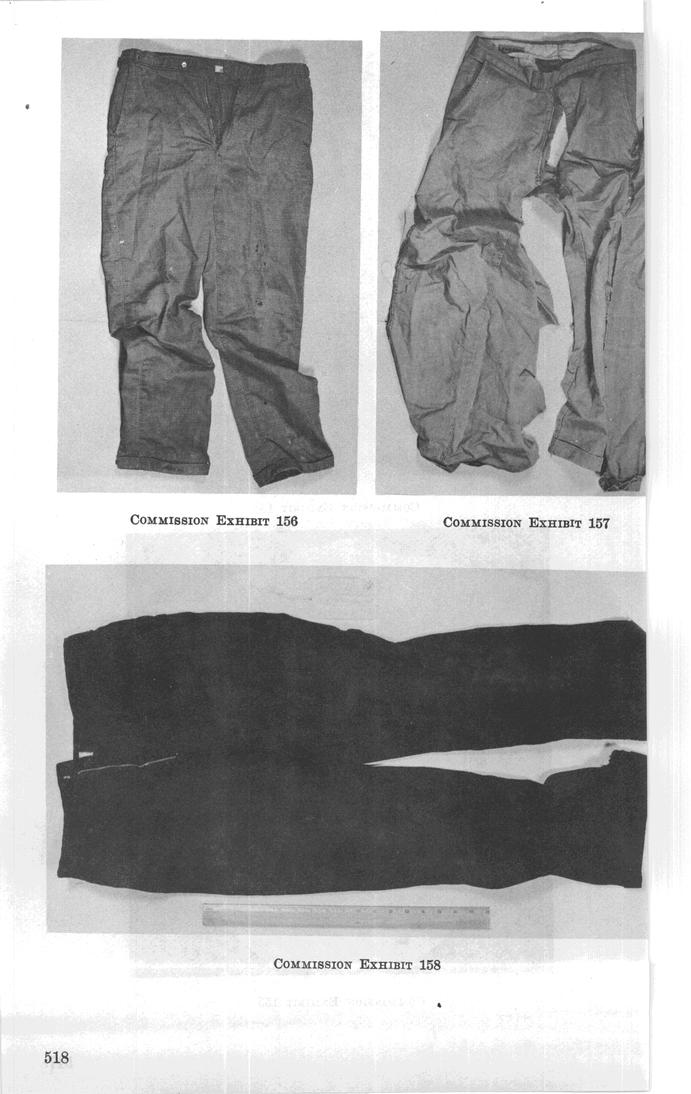
Mr. Ball. Notice the color of his pants?
Mrs. Bledsoe. Yes, they were grey.
Mr. Ball. How far had he been on the bus before he got off?
Mrs. Bledsoe. About three or four blocks.
Mr. Ball. Now, there are two exits from the bus....the middle of the bus and front of the bus....Which exit did he leave?
Mrs. Bledsoe. Front
Mr. Ball. Did anybody else get off at that time when he got off?
Mrs. Bledsoe. No, not then, but there was a lady sitting right across, she wanted to go to the train station....and she was worried about trying to get off, you know, trying to get there, and then we were hearing her, and I said, “Well, why don't you walk over there. It's just a little ways.
Mr. Ball. Did she ask for a transfer?
Mrs. Bledsoe. Yes
Mr. Ball. Now, had the bus gone as far as Lamar Street, when Oswald got off?
Mrs. Bledsoe. Yes. No; I think before we got to Lamar St.
Mr. Ball. Close to Lamar?
Mrs. Bledsoe. Yes, close.
About 4 minutes after (HARVEY) Oswald boarded McWatters' bus, the bus was stopped in traffic, near Poydrus street. A man got out of the car in front of the bus and told McWaters the President had been shot. (HARVEY) Oswald got up from his seat, as did the blond-haired woman, and both obtained bus transfers from McWatters before leaving the bus. McWatters later told the WC, “Yes, sir; I gave him one [bus transfer] about two blocks from where he got on [at Griffin]... that is the transfer because it had my punch mark on it.... I gave only two transfers going through town on that trip and that was at the one stop of where I gave the lady and the gentlemen that got off the bus, I issued two transfers....But that was the only two transfers were issued [on that ONE trip thru town].
NOTE: On 11/22/63 McWatters issued bus transfers #004452 thru #004457 to passengers during several trips he made thru town. But on the trip thru town where he picked up the lady and (HARVEY) Oswald he issued only two transfers--#004458 to the lady and #004459 to Oswald.
McWatters told the WC, “The reason I recall the incident, I had--there was a lady that when I stopped in this traffic, there was a lady who had a suitcase and she said, I have to make a 1 o'clock train at Union station....so I gave her a transfer and opened the door and as she was going out the gentlemen I had picked up about 2 blocks asked for a transfer and got off at the same place in the middle of the block where the lady did....it was the intersection near Lamar St.”
Mary Bledsoe overheard the woman's comment about the Union Station and said, “Why don't you walk over there. It's just a little ways.”
NOTE: It is very important to remember that McWatters, Bledsoe, and Jones all remembered the blond lady getting on the bus at the same time as (HARVEY) Oswald, getting off the bus at the same time as (HARVEY) Oswald, and both the lady and (HARVEY) Oswald were given bus transfers by McWatters. And when (HARVEY) Oswald was arrested the bus transfer, given to him by McWatters, was found in his shirt pocket.
When McWatters' bus reached Houston, he would always turn left and within a few blocks pass the train station. There was no legitimate reason for the lady to request a transfer, as the train station was only a few blocks further on McWatters route. But if this woman was following (HARVEY) Oswald, then there was a very good reason for her to get a transfer.
Roy Milton Jones also remembered the blond-haired woman. When the bus was stopped in traffic, and prior to the appearance of the police, the woman left the bus by the rear door to catch a train at the depot and the man who was sitting behind him ((HARVEY) Oswald) left the bus by the front door while the bus was in the middle of the block.
BUS TRANSFER #4459
The bus transfer given to Oswald was authenticated by several means. Mr. FF Yates, Division Superintendent of the Dallas Transit System, told the FBI that company drivers get the amount of transfer books (50 transfers to a book) they think they will need when they go on duty each day. The driver tears off the first transfer of each book, writes his badge number on the back of this transfer, and leaves it in the station office. If a passenger had a complaint, their transfer could be brought to a supervisor and the bus and driver would be quickly identified by the number appearing on the transfer. In addition, each transfer given to a passenger would be "punched" by the bus driver who issued the transfer. Every driver was issued a punch which produced a unique punch mark, which would identify the driver.
Bus driver Cecil McWatters was issued a book of 50 bus transfers (#4451 to #4500). He tore off transfer #4451, the first transfer from a book of 50 transfers (#4451 to #4500). He then wrote his badge number (No. 195) on the back side of this transfer and left this transfer (#4451) in the station office. These "identification transfers," which identified the name of the driver who issued a particular transfer, were kept in the station office for two months and then routinely destroyed.
The
bus transfer given by Cecil McWatters to HARVEY Oswald was #4459. On
March 3, 1964 the FBI interviewed Mr. F.F. Yates, Division
Superintendent of the Dallas Transit System. Yates told the FBI that he
was unable to find a record of the transfer book(s) issued to Cecil
McWatters on 11/22/63. This was because all of the "identification
transfers" for bus transfers issued to bus drivers on 11/22/63 were
kept in the station office for two months and then routinely destroyed.
The "identification transfer (#4451)" for book #4451 to #4500, which
contained the transfer given to HARVEY Oswald (#4459) on 11/22/63,
would have been routinely destroyed two months later (by the end of
January, 1964).
Fortunately, the "identification transfer" (#4451), left in the station office by Cecil McWatters on 11/22/63, had been retained as a souvenir by James. F. Routt, the Station Supervisor. On the back side of bus transfer #4451 was a note that read, "Receipt for the book of transfers from which transfer was issued to Oswald, the accused assig of Pres. John F. Kennedy." The note was signed by J.D. Routt, Sta. Foreman.
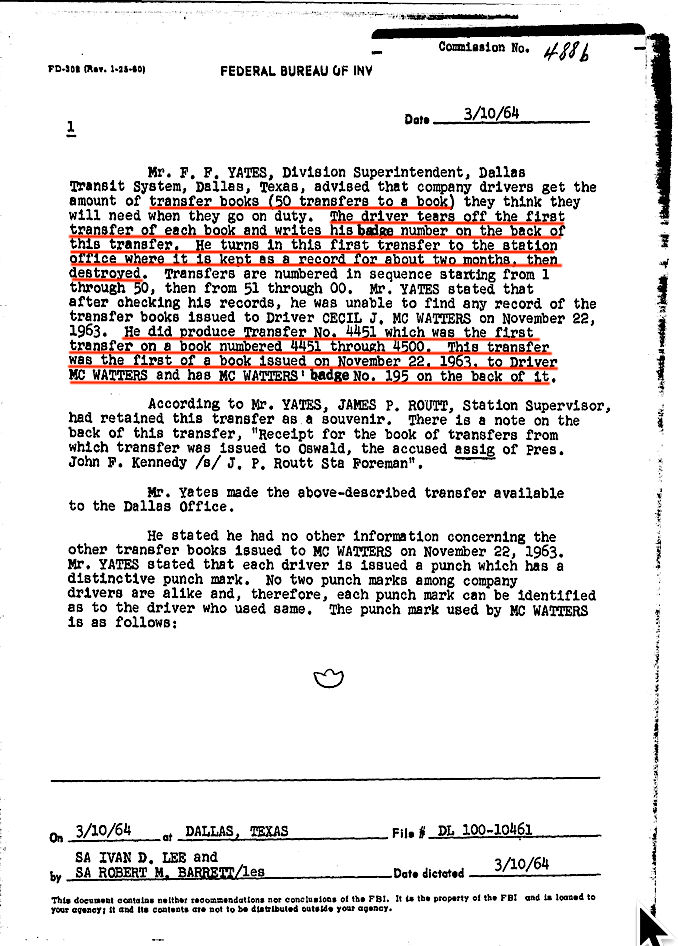
NOTE: After (HARVEY) Oswald was arrested, and a bus transfer was found in his shirt pocket, the police called the Dallas Transit System. They spoke with Division Superintendent Mr. F.F. Yates, and inquired about bus transfer #004459. Yates quickly determined that this transfer came from a book of transfers that began with transfer #004451, with badge number 195 written on the back side. Yates identified Cecil McWatters to the police as the driver who had issued transfer #004459.
When Oswald asked for a transfer, McWatters tore transfer #004459 from the book at the “1....0” mark, which meant the transfer was valid until 1:00 PM. According to company rules, drivers were supposed to punch transfers at 15, 30 and 45 minutes past the hour. But McWatters punched his transfers by the hour. McWatters told the WC, "In other words, when I am going one way at 1 o'clock, coming back from the other end of the line I set them at 2. I am back in there at, my next trip I am back in there at Lamar Street, I think it is 1:38 but I always set them at 2 o'clock....While at Marsalis [heading toward the southern end of Marsalis] I would punch the Lakewood; when I would leave Marsalis coming toward Lakewood [heading north], I would have "Lakewood" on the front of my bus [referring to the "scroll" sign above the windshield indicating a bus's destination] but I would punch the transfer Marsalis".
McWatters punched the transfer under the heading “PM” (afternoon), and gave it to (HARVEY) Oswald. The transfer that McWatters left at the bus station early that morning (#004451) and the transfer given to (HARVEY) Oswald (#004459) are identical, except for the numbering and the fact that #004459 was torn off at the “1......0” mark (1:00 PM).
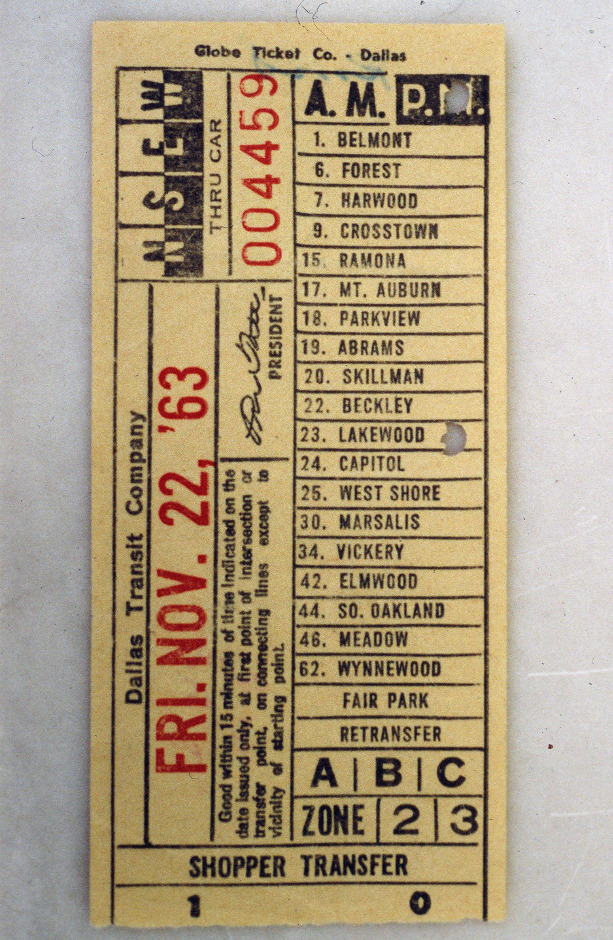 |
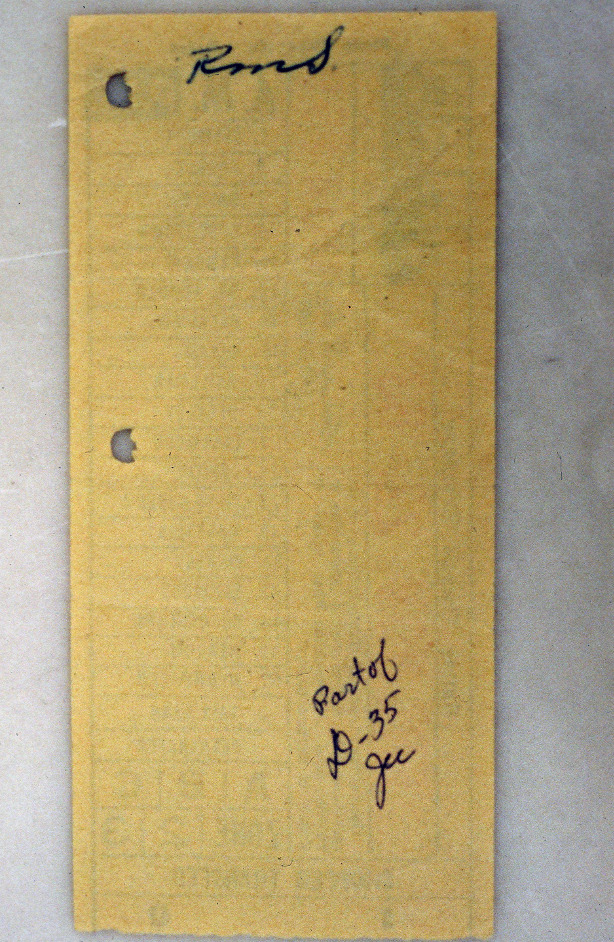 |
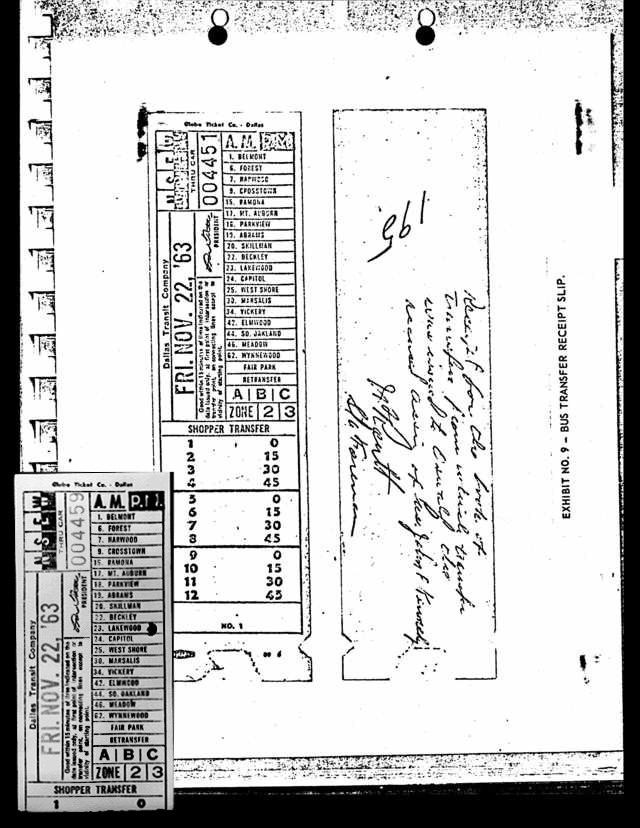
During his first interrogation, which began at 2:20 PM--only one-half hour after his arrest-- (HARVEY) Oswald told Capt. Fritz, in the presence of Det. Elmer Boyd, Det. M.G. Hall, Det. Richard Sims, and FBI Agents Bookhout and Hosty, that he rode a bus home. Later that afternoon the police found a bus transfer in Oswald's shirt pocket and soon interviewed bus driver Cecil McWatter. The following day, at 10:30 AM, (HARVEY) Oswald was again interrogated by Capt Fritz in the presence of SS Agent Thomas Kelley, FBI agent Jim Bookhout, US Marshall Robert Nash, SA David Grant, SAIC Forrest Sorrels, Det. Elmer Boyd, and Det M.G. Hall. Harvey Oswald again said that he rode a bus and secured a bus transfer (which was removed from his shirt pocket by Det. Sims the previous day). A total of seventeen people, including a Secret Service Agent, a US Marshall, FBI Agents, DPD Detectives, and Capt Fritz were present during interrogations when (HARVEY) Oswald said that he rode a bus. Twelve people were present during interrogations when (HARVEY) Oswald said that he had obtained a bus transfer.
THE BUS RIDE WAS PRE-PLANNED BY THE CONSPIRATORS
JFK researchers have long wondered
why (HARVEY) Oswald boarded the Marsalis Ave. bus #433 instead of
boarding the Beckley bus, which he normally rode to and from the TSBD
and stopped close to his rooming house. Why the Marsalis Ave. bus?
Because (HARVEY) Oswald was following orders/instructions.
The pre-planned Marsalis Ave. bus trip explains why Stuart L. Reed, a civilian employee of the US Army who was then working in the Panama Canal Zone, was in Dallas on 11/22/63, and why he took photographs of the front and rear of this particular bus—purportedly Cecil McWatters' bus, #433, run #1213 (see photos below). Reed was a long way from Panama on 11/22/63, but he was not in Dealey Plaza to take photographs of the President's motorcade. Following the shooting of President Kennedy Stuart Reed was a few blocks east of the TSBD, on Elm Street. There is no innocent explanation as to why he photogaphed the front of this bus and then photographed the back side of the same bus a few minutes later near the TSBD, about the time two Dallas Police officers boarded McWatters' bus looking for the assassin of President Kennedy. If (HARVEY) Oswald had not gotten off the bus a few minutes earlier, at Lamar St., he would have been on the bus when police boarded the bus. And Stuart Reed would have color slides of (HARVEY) Oswald either being arrested or perhaps shot and killed on the bus by the two policeman. But why would Stuart Reed, or anyone, ignore President Kennedy's motorcade and instead take photographs of the front and back of a city bus? Because (HARVEY) Oswald, the man who would soon be accused of killing President Kennedy, was supposed to be on this bus.
NOTE: The identity of the police officers who boarded McWatters' bus #433, and the identity of their superior officer(s), are unknown. There are no DPD reports nor FBI reports that report or mention police officers boarding a city bus, only the statement of bus passenger Roy Milton Jones.
This pre-planned
route of escape for HARVEY Oswald could explain why a lady boarded
McWatters' bus the same time as (HARVEY) Oswald, in the middle of
Elm St. When (HARVEY) Oswald got a bus transfer, the lady got a
bus transfer. A few minutes later, when (HARVEY) Oswald got off
the bus, the lady got off the bus at the same time. Did this lady
follow (HARVEY) Oswald to the Greyhound Bus station whree (HARVEY)
Oswald got into William Whaley's taxi? After (HARVEY) Oswald opened the
door and got in the front seat of the taxi, a lady hurried to the taxi
and asked driver William Whaley to call her a taxi. The author believes
this lady was probably the same lady from McWatters' bus, and she was
following (HARVEY) Oswald.
(HARVEY) Oswald may have been told by one of his handlers (likely
Bill Shelley) that he was to meet up with a contact who would drive him
to the Texas Theater (probably Officer J.D. Tippit, who was sitting and
probably waiting for (HARVEY) Oswald in his patrol car at the GLOCO
Station). The Marsalis Ave. bus #433, driven by Cecil McWatters, drove
across the Houston Street viaduct, turned left on Marsalis St., and
then stopped for passengers. This bus stop, where passengers deboarded,
was across the street from where Officer Tippit was sitting in his
patrol car. The GLOCO Station was 1.3 miles east of Oswald's rooming
house--a 20 minute walk.
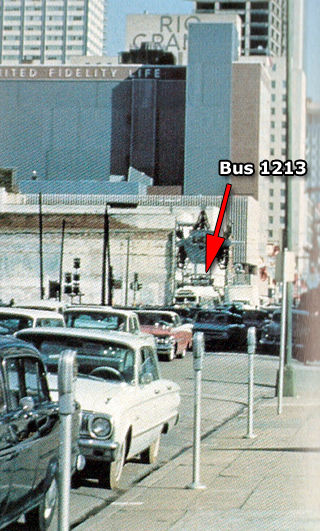 |
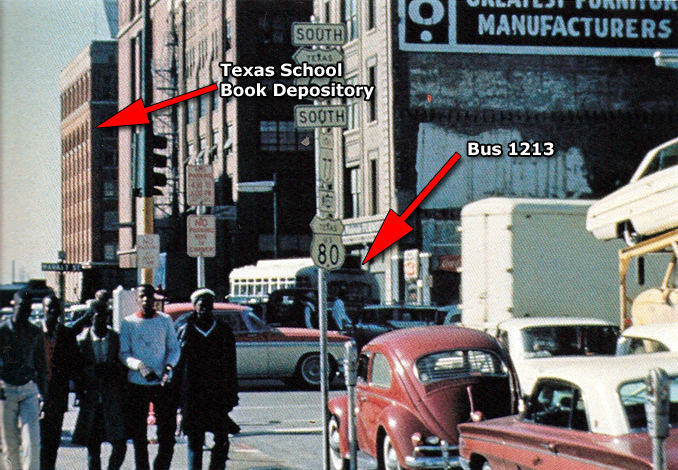 |
| Above: Photographs
taken by Stuart Reed of McWatters' bus on Route 1213. Below: Warren Commission photos of McWatters' bus, Fleet #433. |
|
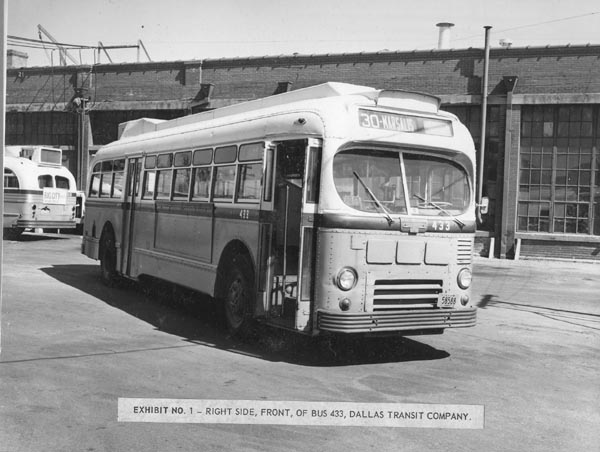 |
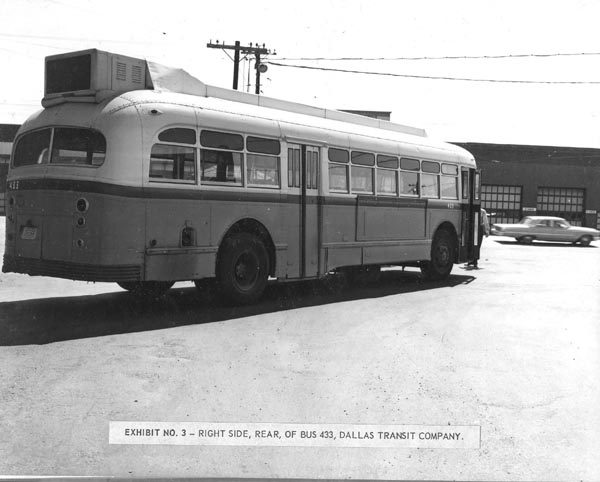 |
A few minutes after taking photographs of
the front and back of a city bus, Stuart Reed took a photograph of the
TSBD with the “snipers window” in plain view (below). Reed's next
photographs, taken one hour later, were even more “fortuitous.” Reed
took a series of color slides that showed (HARVEY) Oswald as he was
being taken out the front of the Texas Theater by police. Color
slides of the getaway bus, the sniper's nest, Oswald's arrest. We
have to wonder why Reed was not in Dealey Plaza taking color slides of
the President's motorcade and the aftermath of confusion. Instead,
Reed's uncanny ability to be in the right places, at the right times,
and take professional-quality color slides on 11/22/63 strongly
suggests that his actions, and the color photos he took, may have been
directed by someone who knew (HARVEY) Oswald's pre-planned schedule.
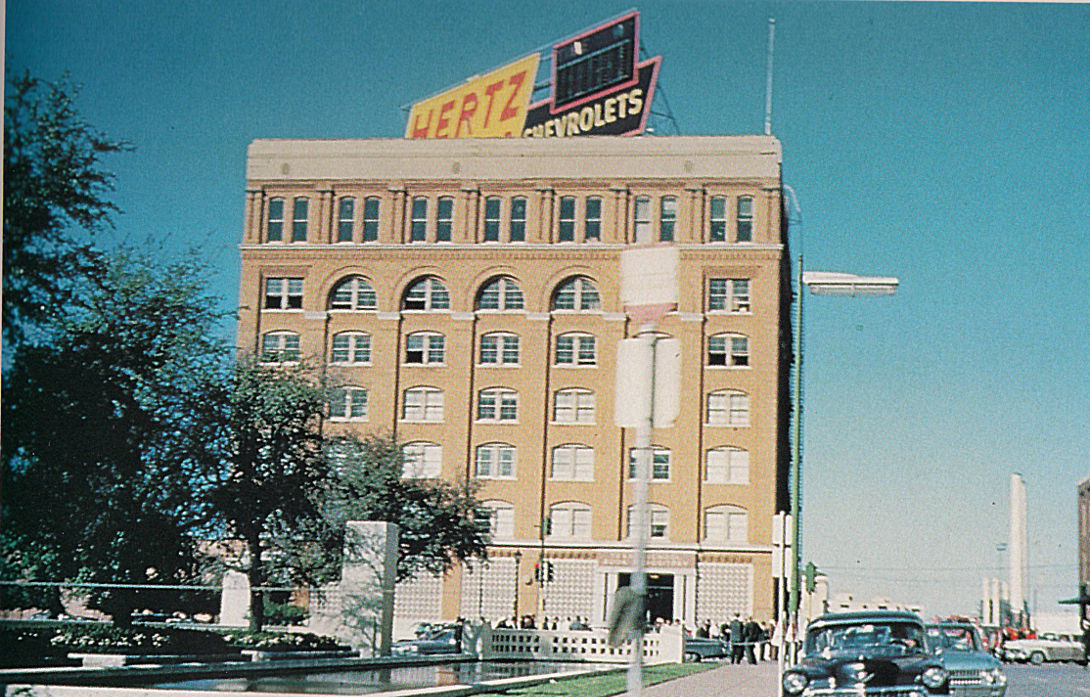
At
12:44 PM (HARVEY) Oswald began walking
south on Lamar St. toward the Greyhound bus station. The blond-haired
lady from Cecil McWatters Marsalis Ave. bus may have been following
him. (HARVEY) Oswald, with a bus transfer valid until 1:00 PM, was
walking south and distancing himself from McWatters' bus and the
traffic jams on Elm St.
WILLIAM WHALEY AND THE TAXI
Mr. Ball: About 12:30 that day where were you?
Mr. Whaley:....I just pulled up about 30 feet to the [taxi] stand and stopped and then I wanted a package of cigarettes, I was out so I started to get out and I saw this passenger coming so I waited for him...He was walking south on Lamar from Commerce when I saw him....He didn't talk. He wasn't in any hurry. He wasn't nervous or anything. He was dressed in just ordinary work clothes. It wasn't khaki pants but they were khaki material, blue faded blue color....The t-shirt was a little soiled around the collar but the bottom part of it was white....Then he had on a brown shirt with a little silverlike stripe on it and he had on some kind of jacket, I didn't notice very close but I think it was a work jacket that almost matched the pants [grey color]....That jacket now it might have been clean, but the jacket he had on looked more the color, you know like a uniform set, but he had this coat here on over that other jacket, I am sure, sir.
Mr. Ball. This is the blue-gray jacket, heavy blue-gray jacket?
Mr. Whaley. Yes, sir.
There
are now three people who said that (HARVEY) Oswald had a
grey/light blue jacket—bus driver Cecil McWatters, bus passenger Roy
Milton Jones, and taxi driver William Whaley. And three people who
remember (HARVEY) Oswald's grey-colored pants--bus driver Cecil
McWatters, and bus passemgers Roy Milton Jones and Mary Bledsoe.
Mr. Ball ...tell me about that, what the passenger said.
Mr. Whaley. He said, “May I have the cab?” I said, “You sure can. Get in.” [the time was 12:47-48 PM] And instead of opening the back door he opened the front door, which is allowable there, and got in. A lady, I don't remember whether she was very old, but the was middle-aged....She bent down and stuck [her head] in and said, “Driver, will you call me a cab down here?” He [LHO] said, “I will let you have this one,” and she said, “No, the driver can call me one.” I asked him where he wanted to go. And he said, “500 North Beckley.” I turned to the left off Lamar onto Jackson, went one block to Austin, then from Austin I turned to the left again and went one block over to Wood Street....to Houston which is the street which we call the old viaduct. Went across the viaduct to Zangs....Beckley turns off [to the left]....When I got pretty close to 500 block at Neches and North Beckley which is the 500 block, he said, “This will do fine.” He gave me a dollar bill, the trip was $.95....didn't say anything, just got out and closed the door and walked around the front of the cab over to the other side of the street....I put it in gear and moved on, that is the last I saw of him [the time was 12:53-54 PM].
Mr. Ball. Can you tell me what distance that was?
Mr. Whaley. About 2 1/5 miles, sir.
Mr. Ball. Can you give me any estimate of the time it took you to go that 2 ½ miles?
Mr. Whaley. Nine minutes.
Mr. Belin. When we went out there today, when we started the stopwatch from the Greyhound bus station to the 700 block of North Beckley, do you know about how many minutes that was on the stop watch?
Mr. Whaley. A little more than 5 minutes, between 5 and 6 minutes.
Mr. Ball. Was there anything in particular about him beside his clothing that you could identify such as jewelry, bracelets?
Mr. Whaley. Yes, sir: he had on a bracelet of some type on his left arm. It looked like an identification bracelet....I always notice watchbands, unusual watchbands, and identification bracelets like these, because I make them myself ... It was just a common stretchband identification bracelet. A lot of them are made of chain links and not stretchbands. Stretchbands are unusual because there is very few of them."
NOTE: (HARVEY) Oswald's bracelet is listed on a DPD property form, found in Box 1, folder 8, item 1 at the Dallas Archives. It is identified as "One I.D. stretch band with 'Lee' inscribed.”
Taxi driver William Whaley was unknown to the police until early the following morning, 11/23/63. Yet a few hours after the taxi ride, a photograph of (HARVEY) Oswald shows a stretch band bracelet on his left arm (see photo below). This photo was taken prior to the police removing the bracelet and placing it into evidence. Whaley could only have known about a bracelet on (HARVEY) Oswald's left arm if he had seen it himself during the taxi ride.
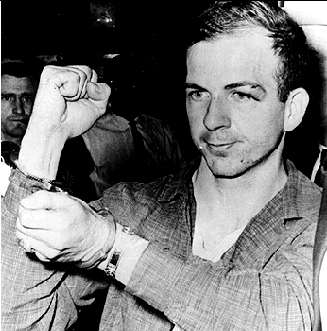
Perhaps the most important confirmation that (HARVEY) Oswald was in Whaley's taxi cab comes from Oswald himself:
On the morning of 11/23/63 Capt. Fritz was told that a taxi driver identified Oswald as one of his passengers around noon on 11/22/63. Capt. Fritz then asked Oswald if he had ridden a taxi. Harvey Oswald said that when he got on the bus he found it was going too slow and after two blocks he got off the bus and took a cab to his home. Oswald's story about riding in a taxi matches perfectly with what Whaley told his supervisors earlier that morning. How could their stories have matched, unless LHO rode in Whaley's taxi?
Oswald told Capt. Fritz about the blond-haired lady who asked Whaley to call her a taxi. And Whaley told the same story to the police. How could their stories match if the incident with the blond woman never happened?
Oswald's silver-colored
stretch band bracelet was removed at police headquarters. How could
Whaley have known about this bracelet unless LHO was a passenger in his
taxi?
Oswald told Capt. Fritz this was the first time he rode in a taxi, and he paid 85 cents for the taxi fare. Whaley told the police the taxi fare was 95 cents. Once again, how could their stories match so closely, unless Oswald had ridden in Whaley's cab?
William Whaley was required, by his company and by the city of Dallas, to keep a trip manifest that contained information related to his trips. Mr. Ball asked Whaley questions about his trip manifest for November 22, 1963.
Chairman: The witness has been driving a taxicab in Dallas for 36 years.
Mr. Whaley: Thirty-seven, sir.
Mr. Ball. Tell me when you make entries, you make the entries when?
Mr. Whaley. Sometime I make them right after I make the trips, sir, and sometimes I make three or four trips before I make the entries....[Whaley made the entry on his manifest for the trip to N. Beckley after returning to the Union terminal]
Mr. Ball: Are you required by your employer to describe the trip, where you went, how far it was?
Mr. Whaley: Not by the employer, sir....The city of Dallas ordinance requires that you put down where you picked the passenger up, where you unload the passenger.
Mr. Ball: Now, the manifest does contain that information, though, does it?
Mr. Whaley: Yes, sir, it does....I was at the Greyhound bus station. I have a copy of my trip sheet here...You look down there it says Greyhound, 500 North Beckley, I think it is marked 12:30 to 12:45. Now that could have been 10 minutes off in each direction because I didn't use a watch, I just guess, in other words, all my trips are marked about 15 minutes each....It is a trip sheet manifest. The company gets the amount of money you have run, your meter reading and all, and they have to keep it because of the city ordinance requirement that the taxis make this kind of manifest.
William Whaley's trip manifest was clocked in at 5:05 AM on November 22nd. Beginning meter readings listed on Whaley's trip manifest consisted of the total number of trips (3591), the units (8308--one unit for every 4/10 of a mile) and the total miles (6011). With each successive trip each of these meter readings would automatically increase and be totaled and logged in at the end of each day. In addition to the automatic meter readings, cab drivers also listed the amount of each fare, the number of passengers, the time "in and out" and the mileage "in and out". At the end of the day, drivers turned in their manifests, which were "date stamped" along with the amount of cash which was recorded on the manifest with a "machine stamp." Whaley's last fare on November 22nd ended at 3:45 pm. His trip manifest was stamped "NOV 22" and 25.15 CA ($25.15 --- the amount of cash turned in by Whaley).
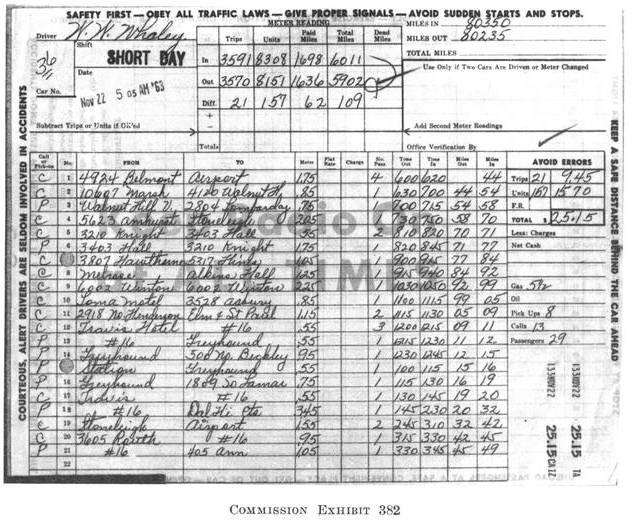
As Whaley was driving (HARVEY) Oswald to 500 N. Beckley, as instructed, the Marsalis Ave. bus was stopped on Elm St., sitting in traffic. The bus didn't arrive on schedule at Zang and Marsalis, when Tippit was sitting in his police car across the street at the GLOCO Station. But a few minutes after the bus failed to arrive on time, Officer Tippit was seen by witnesses leaving the station in a hurry and driving south on Lancaster St., one short block east of Marsalis. A few minutes later Tippit arrived at the Top 10 Record Store and made a “hurried” phone call. While Tippit was at the Top 10 store (HARVEY) Oswald got out of Whaley's taxi, paid 95 cents in taxi fare (Whaley said 95 cents; Oswald said 85 cents), and began walking toward his rooming house.
. . . AND SOON ARRIVES AT THE TEXAS THEATER
After a 5 minute, 45 second walk (HARVEY) Oswald arrived at his rooming house (12:59 to 1:00 PM). Housekeeper Earlene Roberts said, "I don't recall what type of clothing he was wearing... he went to his room for a few minutes. Then I noticed he had a dark color jacket on, the type that zips up the front." FBI Agent Bardwell Odum, who observed (HARVEY) Oswald as he was being brought out the front of the Texas Theater, said (HARVEY) Oswald was wearing a "brown jacket". Several witnesses mistakenly identified Oswald's brown shirt as a jacket. His shirt, with a collar that laid flat (instead of button down) and only two buttons at the bottom of the shirt placket, may have appeared to be a jacket at first glance.
While in his room (HARVEY) Oswald
changed his light grey pants to a pair of very dark (black) pants. He
also changed his t-shirt, “dirty around the collar,” as observed by
taxi driver William Whaley. While changing clothes a Dallas police car
drove slowly past the rooming house and briefly honked the horn.
(HARVEY) Oswald quickly left his rooming house wearing the same dark
color (grey/blue) jacket picked up from the Domino Room, wore it on
McWatters bus, wore it in Whaley's taxi, and was wearing it when he was
last seen by landlady Earlene Roberts standing near the corner
of Beckley and Zang about 1:01-1:02 PM. Five to six minutes later
(HARVEY) Oswald entered the Texas Theater--a mile south and a 20 minute
walk--without a dark color jacket. He was seen by theater
employee Butch Burroughs who said Oswald arrived at 1:07 PM (see Jim
Marrs' videotaped interview with Butch Burroughs) and later sold him
popcorn. How did (HARVEY) Oswald get from his rooming house to the
Texas Theater within 5-6 minutes, unless driven by car?
(HARVEY) Oswald was arrested by police
in the Texas Theater. As (HARVEY) Oswald was being escorted from the
theater, Stuart Reed took a series of color slides of his arrest. After
taking pictures of the front and back of a city bus (purportedly
Oswald's getaway bus), the "snipers window" at the TSBD, and (HARVEY)
Oswald's arrest, Reed took his exposed color transparency film to the
Dynacolor lab in
Dallas (for developing) and then traveled to New Orleans. On Nov 26, in
New Orleans, Reed signed a document that gave the FBI “unrestricted
permission” to pick up and utilize his film and slides for their
investigation. We don't know how many color slides were taken by Stuart
Reed on 11/22/63. We only know that 14 color slides survived.
Stuart Reed was a civilian, employed by the US Army for 34 years, and
on 11/22/63 was in Dallas taking photographs of (HARVEY) Oswald's
whereabouts from 12:40 PM to 1:50 PM.
|
|
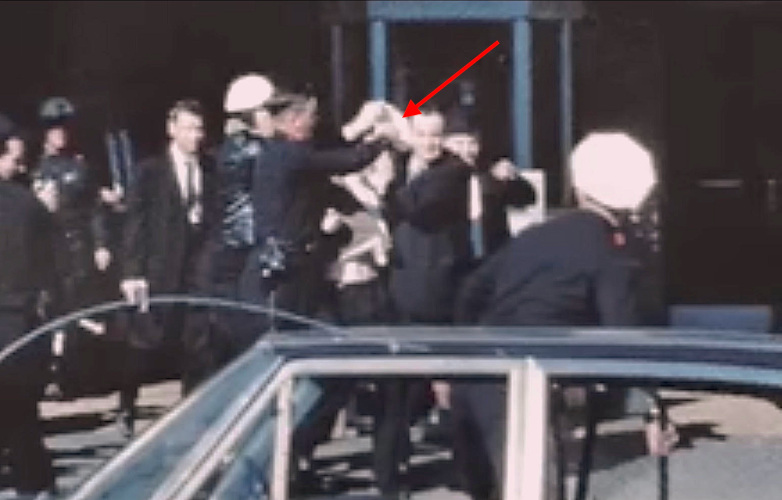 |
| Capt.
Westbrook ordered his officers to “cover his [Oswald's] face” and “get
him out of here.” The famous Stuart Reed photo at left shows an officer's cap near Oswald's face, but the photo at right shows Oswald's face almost entirely hidden by the cap. |
|
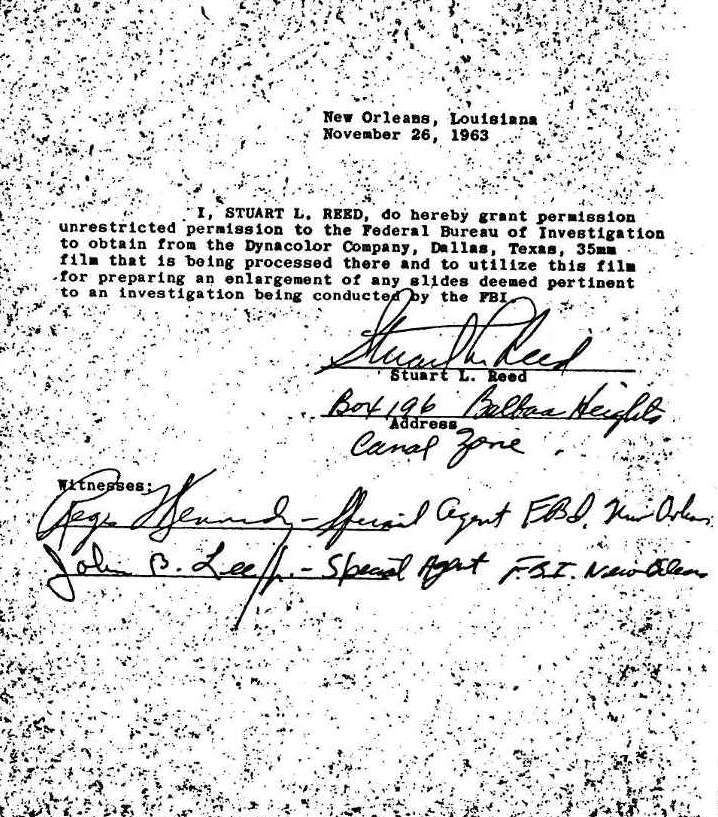
HARVEY OSWALD AT DPD HEADQUARTERS
Shortly after 2:00 PM Deputy Sheriff Roger Craig received word that a young man suspected of being involved in the President's murder had been arrested. He immediately thought of the man running down the grassy knoll and made a telephone call to Capt. Will Fritz. Craig provided Fritz with a description of the man he had seen enter the Nash Rambler. Fritz told Craig that his description sounded like the man they had in custody and asked him to come to police headquarters.
When Craig arrived at the police station he saw (HARVEY) Oswald, thru a glass window, sitting in a chair in an office. Craig told Capt. Fritz this was the man he saw run down the grassy knoll and get into the Nash Rambler. The two men went into the office and confronted (HARVEY) Oswald. Fritz told Oswald, “This man [pointing to Craig] saw you leave.” (HARVEY) Oswald replied, “I told you people I did.” Fritz then said, “Take it easy, son—we‘re just trying to find out what happened....What about the car?” (HARVEY) Oswald leaned forward on the desk and said, “That station wagon belongs to Mrs. Paine—don‘t try to drag her into this” (of course not, Mrs. Paine worked for the CIA). (HARVEY) Oswald then sat back in his chair and said in a calm, very low voice, “Everybody will know who I am now.”
(HARVEY) Oswald heard Capt. Fritz say
"car," yet he responded by using the words "station wagon." Why?
Even more important was (HARVEY) Oswald's statement, "that station
wagon belongs to Mrs. Paine." Did (HARVEY) Oswald suspect that
Mrs. Paine was somehow involved? (HARVEY) Oswald knew that Roger Craig
didn't see him get into the station wagon. Could (HARVEY) Oswald have
suspected that Roger Craig saw LEE Oswald getting into a station wagon?
And could (HARVEY) Oswald also have thought that this station wagon
belonged to Mrs. Paine? Whatever (HARVEY) Oswald was thinking,
handcuffed and sitting in Capt. Fritz's office, he could say nothing
more--he had already said too much (about Mrs. Paine and the station
wagon).
On April 1, 1964 Commission attorney David Belin took testimony from Roger Craig. Craig told the Commission that he saw (LEE) Oswald, wearing a white t-shirt, leave Dealey Plaza in a Nash Rambler station wagon. Belin showed Craig two sets of clothing for identification, each in a separate cardboard box. After Craig identified Oswald's clothing, Belin declined to make Craig's identification part of the Commission's record.
Roger Craig thought that Belin was uninterested in his testimony and said, "He acted like the quicker he got it over with the better." In his autobiography, When They Kill a President, Craig wrote that David Belin changed his testimony 14 times. Craig told the Commission the license plates on the Rambler were NOT the same color as Texas plates, but the Commission omitted the word "NOT" and made it appear as though they were the same color as Texas plates. Craig said the Rambler station wagon was light green but the Commission changed the color to a white station wagon.
At 12:40 PM Deputy Sheriff Roger Craig watched (LEE) Oswald as he ran down the grassy knowl and get into a Rambler station wagon. A short time later Craig saw (HARVEY) Oswald in the Dallas Police station, and told Capt. Fritz this was the man he saw get into a Rambler station wagon in Dealey Plaza. The Warren Commission ignored Roger Craig's testimony and wrote, "Craig may have seen a person enter a white Rambler station wagon 15 or 20 minutes after the shooting and travel west on Elm Street, but the Commission concluded that this man was not Lee Harvey Oswald, because of the overwhelming evidence that Oswald was far away from the building by that time."
If the Commission (or the HSCA) had followed thru on Craig's testimony, and interviewed Malcolm Robinson, Roy Cooper, Helen Forrest, and James Pennington, they would have learned that a man who closely resembled Lee HARVEY Oswald got into a Nash Rambler station wagon and left Dealey Plaza at 12:40 PM. By ignoring these witnesses the Commission (and HSCA) lost the opportunity to learn what really happened on November 22, 1963. The unanswered question is whether or not the Commission's failure, and the HSCA's failure, was intentional.
Roger Craig was perhaps the most important witnesses to the events that occurred in Dealey Plaza on November 22, 1963. When Craig identified the man in the Dallas Police station (HARVEY Oswald) as the man who he saw enter the Nash Rambler station wagon (LEE Oswald), Craig was very close to exposing HARVEY and LEE, and thereby exposing the assassination of President Kennedy as a conspiracy.
Roger Craig never changed his account of what he witnessed and
experienced on Friday, November 22, 1963. For the rest of his life he
remained convinced that the man who got into the Nash Rambler station
wagon was Lee Harvey Oswald. But Craig's testimony was overlooked,
because it threatened to expose the two Oswalds.
* Roger Craig received honors as a Deputy Sheriff prior to the
assassination, but after testifying before the Warren Commission in
1964 his life began to change. On July 4, 1967 he was fired from the
Sheriff's Department.
* In 1967, after returning from a meeting with New Orleans District
Attorney Jim Garrison, someone shot at Roger Craig and a bullet grazed
his head.
* In 1973 Craig's car was forced off the road in West Texas by an
unidentified individual, causing serious injuries.
* In 1974 Craig opened the door of his house was confronted by a man
who shot him in the shoulder with a blast from a shotgun.
* In 1975, 39-year-old Roger Craig was found dead in his father's home
in Dallas, the victim of a gunshot wound fired from a rifle. His death
was ruled a suicide.
HARVEY OSWALD'S FIRST INTERROGATION--2:20 PM
At 2:00 PM, ten minutes after (HARVEY)
Oswald was arrested, Det. Paul Bentley and Sergeant Hill escorted him
to the Homicide Department on the 3rd floor of police headquarters.
NOTE: While Hill was escorting (HARVEY) Oswald to the Homicide & Robbery Department, he had on his person the .38 revolver taken from Oswald at the Texas Theater. Instead of leaving the gun with Capt. Fritz in Homicide & Robbery Hill took the gun to Capt. Westbrook's office and placed it on a desk next to Westbrooks desk. One hour later a .38 revolver was initialed as evidence by several police officers in Westbrooks office and then given to Homicide & Robbery.
(HARVEY) Oswald was placed inside one of the interrogation rooms with Officer C.T. Walker, who asked Oswald, “Did you kill the officer because you were scared of being arrested for something?” Oswald replied, “I'm not scared of anything. Do I look like I am scared now?” Walker remembered that Oswald did not look like he was scared; he was calm, and he was not a bit nervous. Det. Gus Rose arrived, looked thru Oswald's wallet, and talked with him for about 20 minutes until Capt. Will Fritz arrived.
Capt. Fritz told the WC, “When I started to talk to this prisoner or maybe just before I started to talk to him, some officer told me outside of my office that he had a room on Beckley, I don't know who that officer was, I think we can find out....” How could any police officer have known that (HARVEY) Oswald had a room on Beckley, only ½ hour after his arrest, and before Fritz began questioning Oswald? There is no evidence that a single police officer asked (HARVEY) Oswald for his address prior to his interrogation with Capt. Fritz. It appears that someone, inside the police department, was familiar with (HARVEY) Oswald. In the author's opinion, this man was Capt. W.R. Westbrook.
At 2:20 PM Capt. Fritz instructed Det. Sims and Det. Boyd to take (HARVEY) Oswald from the interrogation room and escort him into Fritz's small office (9.5 ft x 14 ft). Fritz, Det. Elmer Boyd, Det. M.G. Hall, and Det. Richard Sims were in attendance. At 3:15 PM FBI Agents Bookhout and Hosty joined the interrogation. Hosty's notes reflect that (HARVEY) Oswald was read his rights to have an attorney before questioning, but Hosty and Bookhout arrived nearly an hour after the interrogation began. DPD officer Marrion Baker recognized (HARVEY) Oswald as the man he, along with Roy Truly, had confronted in the lunchroom at the TSBD. Baker overhead parts of the interrogation and said that (HARVEY) Oswald repeatedly demanded an attorney. This is a good indication that Capt. Fritz may not have advised Oswald of his right to an attorney before questioning. And Hosty's notes, wherein he claimed that Oswald had been read his rights, may also not be accurate because Hosty arrived nearly an hour after the interrogation began.
SA James Hosty told the WC that he
destroyed the notes he took during Oswald's interrogation. WC attorney
Stern asked Hosty directly, "Did you yourself destroy the notes." Hosty
replied, "Yes." Stern then asked, "Your interview of Oswald, on
November 22, you put the notes in the wastebasket?" Hosty replied,
"Right.” But SA Hosty's notes are at the National Archives. If Hosty
told the truth to the WC, and he threw his notes in the wastebasket,
then Hosty's notes now in the National Archives were written some time
after Oswald's interrogation. Or, Hosty lied to the WC—he never threw
his notes in the wastebasket, and these are the notes at the National
Archives. Either way SA Hosty's credibility regarding his notes and/or
the content of his notes, is called into question.
(HARVEY) Oswald told Capt Fritz, in the presence of several law
enforcement officers, that he changed clothes and put his pants (light
grey pants) in the lower drawer of his small dresser. Capt. Fritz
took notes of Oswald's interrogation (not published until 1990) and
wrote, “told me he caught a bus and went home.....” Fritz later told
the WC, “I asked him where he went to when he left work, and he told me
he had a room on Beckley, that he went over there and changed his
trousers [the light grey pants seen by Bledsoe and Jones
and Whaley] and got his pistol and went to the picture show.” There was
no mention that (HARVEY) Oswald changed his shirt on 11/22/63.
SA James Bookhout and Secret Service
Agent Thomas Kelley wrote reports about Oswald's interrogations on
11/23/63 and were also questioned by the Commission. Bookhout wrote,
“City bus to his residence....then took a cab to his house.” Kelley
wrote in his report, “got on bus....got off the bus....then took cab to
his home.” Kelley did not discuss Oswald's bus or taxi ride with the WC.
Bus passenger Mary Bledsoe was 67 years old in 1963, divorced, and had
recently suffered a stroke. After arriving home she turned on her
television and began watching coverage about President Kennedy.
Mr. Ball. When did you first notify the police that you believe you'd seen Oswald?
Mrs. Bledsoe. When I got home....I turned on the radio-television....I wanted to hear about the President and there was a little boy came in that room in the back and he turned on, and we listened and hear about Mr. Tippen being shot, and it didn't dawn on me, and I said-told his name as Oswald....and they kept talking about this boy Oswald and had a brown shirt, and all of a sudden, well, I declare, I believe that this was this boy, and his name was Oswald....about an hour my son came home, and I told him, and he immediately called the police and told them....and we went down the next night.
At 4:10 PM the interrogation was interrupted for a lineup for the benefit of Helen Markham, a witness to the murder of Officer J.D. Tippit. Det. Sims, Det. Boyd, and Det. M.G. Hall took LHO to the show-up room. While waiting for the lineup to be arranged (HARVEY) Oswald took off his Marine Corps ring and gave it to Sims. Boyd then searched Oswald and removed 5 rounds of .38 ammunition from the left front pocket of his pants.
Det. Richard Sims removed bus transfer #004459 from the left pocket of (HARVEY) Oswald's long sleeved brown shirt. The bus transfer led police to the Dallas Transit System and to the Division Superintendent, Mr. F.F. Yates. Yates, quickly determined that transfer #004459 came from a book of transfers issued that morning to Cecil McWatters, who wrote his badge number (#195) on the back side of the first transfer (#004451), which he left in the office. Mr. Yates then told police where McWatters could be contacted. After the lineup, which ended about 4:40 PM, LHO was returned to Capt Fritz's office and his interrogation continued.
Det. C.N. Dhority told the WC: “Around 6 PM Detective Brown and myself went out and got Mr. McWatters from the bus in front of the city hall there and brought him into the lineup and took an affidavit of him.” At 6:20 PM Oswald was placed in a 2nd lineup for the benefit of bus driver Cecil McWatters, Ted Callaway, Sam Guinyard, and Howard Leslie Brennan. McWatters, in a signed deposition, said, “I picked up a man on the lower end of town on Elm around Houston (this was Roy Milton Jones). I went on out Marsalis and picked up a woman. I asked her if she knew the President had been shot and she thought I was kidding. I told her if she did not believe me to ask the man behind her that he had told me the President was shot in the temple. This man was grinning and never did say anything. The woman said that it was not a grinning matter. I don't remember where I left this man off. This man looks like the #2 man I saw in the line-up tonight (McWatters identified (HARVEY) Oswald because he was the shortest, smallest man in the lineup as his passenger, but refused to make a positive identification). The transfer #004459 is a transfer from my bus with my punch mark.” During the next week, McWatters saw the “grinning” young man on his bus several times. and realized it was not the man in the police lineup. He told the WC that this boy lived near Brownlee Street, attended school half days, and had a part-time job. McWatters identified this boy to the WC as Milton Jones.
At
6:37 PM the lineup was over and (HARVEY) Oswald was returned to Captain
Fritz's office. While walking through the hallway Oswald responded by
questions asked by reporters and he answered in a loud voice, "I don't
know where you people get your information. I haven't committed any
acts of violence.... I want to get in touch with a lawyer, Mr. Abt, in
New York City.... I never killed anybody."
Det. Dhority, who brought bus driver Cecil McWatters to the police
lineup, later told the WC, “He (McWatters) identified him [(HARVEY)
Oswald] as the man that rode on the bus....after he identified him he
went upstairs and looked at a transfer that Det. Sims had took out of
Oswald's pocket, and he positively identified the transfer as his
transfer. Dhority embellished his testimony regarding McWatters
identification of Oswald as the passenger on his bus. McWatters told
the WC that he was unable to identify Oswald as his passenger, a man
who sat in the middle of the bus for only about 4 minutes.
WC attorney Joseph Ball asked McWatters about the police lineup.
Mr. Ball. Did they show you any prisoner?
Mr. McWatters. Yes, sir....they took me down before the lineup there and asked me if I could identify anyone in that lineup as getting on my bus that day...they brought out four men....they were different ages, different sizes and different heights. And they asked me if I could identify any man in particular there, and I told them that I couldn't identify any man in particular, but there was one man there that was about the size of the man....but as far as positively identifying the man I could not do it.
Mr. Ball. What was the size and the height and complexion of the man that knocked on the window of the bus?
Mr. McWatters. Well, I would say, just like I told the police, to me he was just a medium-sized man. To me he was, I would say, not, I wouldn't call him—just of average weight, and I would say a light-complected, to the best of my knowledge.
Mr. Ball. When you say “average height” what do you mean?
Mr. McWatters. I figured just like I saw, the man, he looked like to me the best way I can describe him would be 135 or 140 pounds.
Mr. Ball. What about height.
Mr. McWatters. Well, just like I told them, it looked like to me he would probably be five-seven or five-eight, in that vicinity.
Mr. Ball. Anyway, you were not able to identify any man in the lineup as the passenger?
Mr. McWatters. No. sir.
Cecil McWatters remembered the height, approximate weight, and clothes of the man who boarded and rode his bus for only 4 minutes. He remembered giving this man a bus transfer, but was unable to specifically identify (HARVEY) Oswald in the police lineup as that man. It is obvious that McWatters, whose memory was not perfect, was honest. He was neither coerced nor pressured to identify Oswald as the man who rode on his bus. Under very difficult conditions, McWatters did the best he could.
After Oswald was returned to Capt. Fritz's office his interrogation continued. SA Bookhout recalled that Fritz asked Oswald if he had killed the President. Bookhout described Oswald's reaction to the WC and said, "He spoke very loudly.....he gave an emphatic denial.....I suppose the word "frantically" would probably describe it." DPD Det. Elmer Boyd, who was also in the room, said that Oswald handled himself well and said, "When someone asked him why he shot the President, that seemed like that's what upset him." DPD officer Marrion Baker overheard one of the interrogators shout at Oswald, "Did you kill the President?.....Did you kill the President?" Oswald shouted back, "That's absurd, I want a lawyer. I want a lawyer!" Baker's testimony shows that certain statements made by Oswald in his defense were not recorded in notes by his interrogators nor were they reported to the Warren Commission. Officer Baker's statement is further reason to believe that Oswald may not have been advised of his right to an attorney.
Capt. Fritz did not report Oswald's repeated demands for an attorney. Fritz simply wrote, "Oswald asked if he was allowed an attorney and I told him he could have any attorney he liked, and that the telephone would be available to him up in the jail and he could call anyone he wished." None of the people present during the interrogation, with the exception of SA Bookhout, reported Oswald's desperate pleas for an attorney.
Fritz told the WC, "I noted that in questioning him that he did answer very quickly, and I asked him if he had ever been questioned before, and he told me that he had. Every time I asked him a question that meant something, that would produce evidence, he immediately told me he wouldn't tell me about it and he seemed to anticipate what I was going to ask." Fritz said, "You didn't have to sit there very long and listen to them talk to Oswald to realize that this guy had been trained in interrogation. By that I mean resisting interrogation."
At 7:40 PM (HARVEY) Oswald was taken by Detectives Sims and Boyd from Captain Fritz's office to the basement for another police lineup. This lineup was for the purpose of having Barbara Jeanette Davis and Virginia Ruth Davis see if they could identify one of the men as the man they saw for a few seconds as he hurried across their front yard at a distance of about 25 feet (Tippit shooting).
At 7:55 PM Detectives Sims and Boyd returned (HARVEY) Oswald to Captain Fritz's office on the 3rd floor. While walking through the hallway Oswald told reporters. "They've taken me in because of the fact that I've lived in the Soviet Union," and then voiced his most famous statement to reporters, "I'm just a patsy."
At 11:00 PM SA Manny Clements questioned Oswald and was joined by DPD Detectives John Adamcik and L.D. Montgomery. Oswald told the investigators that he had lived in Russia and that he liked it there. After answering more questions Oswald said, "I think I have talked long enough. I don't have anything else to say.....what started out to be a short interrogation turned out to be rather lengthy.... I don't care to talk anymore.... I am waiting for someone to come forward and give me legal assistance."
NOVEMBER 23, 1963
The next morning (Saturday), taxi driver William Whaley saw (HARVEY) Oswald's picture in the newspaper. He told his superiors that Oswald had been his passenger the previous day. His supervisors then notified the police, and a police officer relayed the information to Capt. Fritz.
At 10:30 AM, Oswald was brought to Capt. Fritz's office for a 2nd interrogation. Present were SS Agent Thomas Kelley, Jim Bookhout, US Marshall Robert Nash, SS Agent David Grant, SAIC Sorrels, Det. Elmer Boyd, and Det. M.G. Hall.
Capt. Fritz told the WC: “During this interview I talked to Oswald about his leaving the building, and he told me he left by bus and rode to a stop near home and walked on to his house. At the time of Oswald's arrest he had a bus transfer in his pocket. He admitted this was given to him by the bus driver when he rode the bus after leaving the building. But he had told me if you will remember in our previous conversation that he rode the bus or on North Beckley and had walked home but in the meantime, someone had told me about him riding a cab. So, when I asked him about a cab ride if he had ridden in a cab he said yes, he had, he told me wrong about the bus, he had rode a cab. He said the reason he changed, that he rode the bus for a short distance, and the crowd was so heavy and traffic was so bad that he got out and caught a cab, and I asked him some other questions about the cab and I asked him what happened there when he caught the cab and he said there was a lady trying to catch a cab and he told the bus driver, the bus driver told him to tell the lady to catch the cab behind him and he said he rode that cab over near his home, he rode home in a cab. I asked him how much the cab fare was, he said 85 cents....This time he told me a different story about changing the clothing. He told me this time that he had changed his trousers and shirt [singular] and I asked him what he did with his dirty clothes and he said, I believe he said, he put them, the dirty clothes, I believe he said he put a shirt (singular) in a drawer...”
(HARVEY) Oswald told Fritz that he changed his trousers (grey) and a shirt (singular). But Oswald was wearing two shirts on 11/22/63--a white t-shirt and a brown long-sleeve shirt. According to fellow TSBD workers, Oswald wore only his white t-shirt while working inside at the TSBD, and not his long-sleeve shirt. Taxi driver Whaley remembered that Oswald's t-shirt was dirty and soiled around the collar, but the t-shirt Oswald was wearing when photographed at the police station appears to be clean. Oswald told Fritz that he changed a shirt (singular) while in his room on N. Beckley, and it appears likely that he changed only his white t-shirt. There would be no reason for Oswald to change his dark brown long-sleeve shirt, which he had probably not worn while working inside the TSBD.
Secret Service Inspector Thomas J. Kelley wrote, “In response to questions, he stated that this was the first time he had ever ridden in a cab since a bus was always available.” Kelley also wrote, “He said he went home, changed his trousers and shirt, put his shirt[singular] in a drawer. This was a red shirt, and he put it with his dirty clothes. He described the shirt as having a button down collar and of reddish color” (what about the t-shirt?). Kelley's report concerning the shirt differs from the notes of Capt. Fritz. Kelley wrote, “The trousers were grey colored." In response to questions put by Captain Fritz, Oswald said that immediately after having left the building where he worked, he went by bus to the theater where he was arrested; that when he got on the bus he secured a transfer and thereafter transferred to other buses to get to his destination. He denied that he brought a package to work on that day and he denied that he had ever had any conversation about curtain rods with the boy named Wesley who drove him to his employment. Fritz asked him if he had ridden a taxi that day and Oswald then changed his story and said that when he got on the bus he found it was going too slow and after two blocks he got off the bus and took a cab to his home; that he passed the time with the cab driver and that the cab driver had told him that the President was shot. Oswald said that his cab fare was 85 cents. In response to questions, he stated that this was the first time he had ever ridden in a cab since a bus was always available.
FBI Agent James Bookhout wrote, “Following his departure from the Texas School Book Depository, he boarded a city bus to his residence and obtained transfer upon departure from the bus. He stated that officers at the time of arresting him took his transfer out of his pocket. Oswald stated that it was not exactly true as recently stated by him that he rode a bus from his place of employment to his residence on November 22, 1963. He stated actually he did board a city bus at his place of employment but that after a block or two, due to traffic congestion, he left the bus and rode a city cab to his apartment on North Beckley. He recalled that at the time of getting into the cab, some lady looked in and asked the driver to call her a cab. He stated that he might have made some remarks to the cab driver merely for the purpose of passing the time of day at that time. He recalled that his fare was approximately 85 cents. Bookhout said that Oswald told Fritz he placed these clothes in the lower drawer of his dresser. His dirty clothes consisted of a reddish-colored, long-sleeved shirt with a button down collar and grey-colored trousers (what about the dirty t-shirt?). Bookhout's report concerning the shirt, like Kelleys, also differs from the notes of Capt. Fritz.
NOTE:
We must remember that both Shelley and Lovelady were
seen together two minutes earlier near the stairway and freight
elevators on the first floor at 12:31 PM by Victoria Adams, and were
seen together a minute later by Officer Baker and Roy Truly at 12:32 PM
(identified as 2 "white men" by Baker).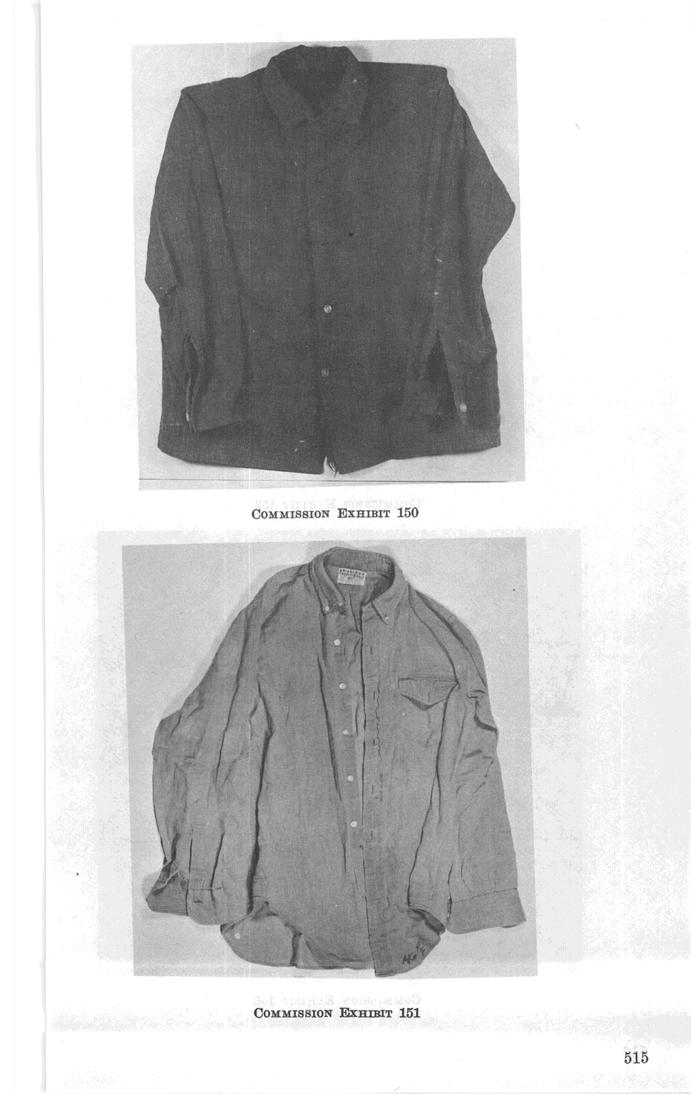 |
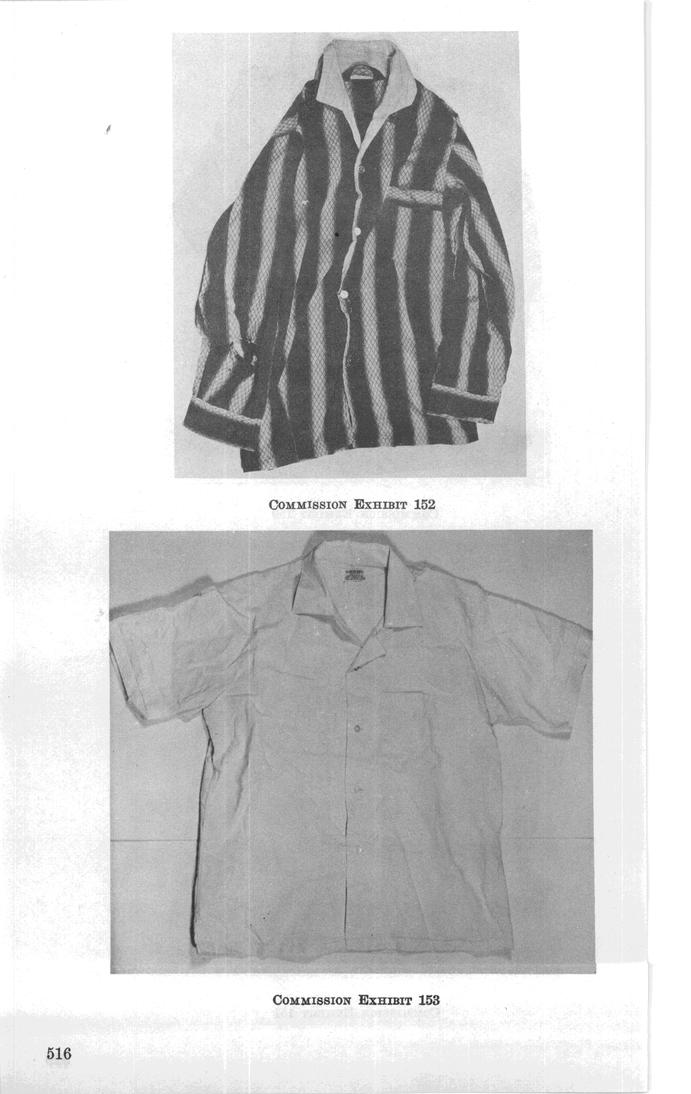 |
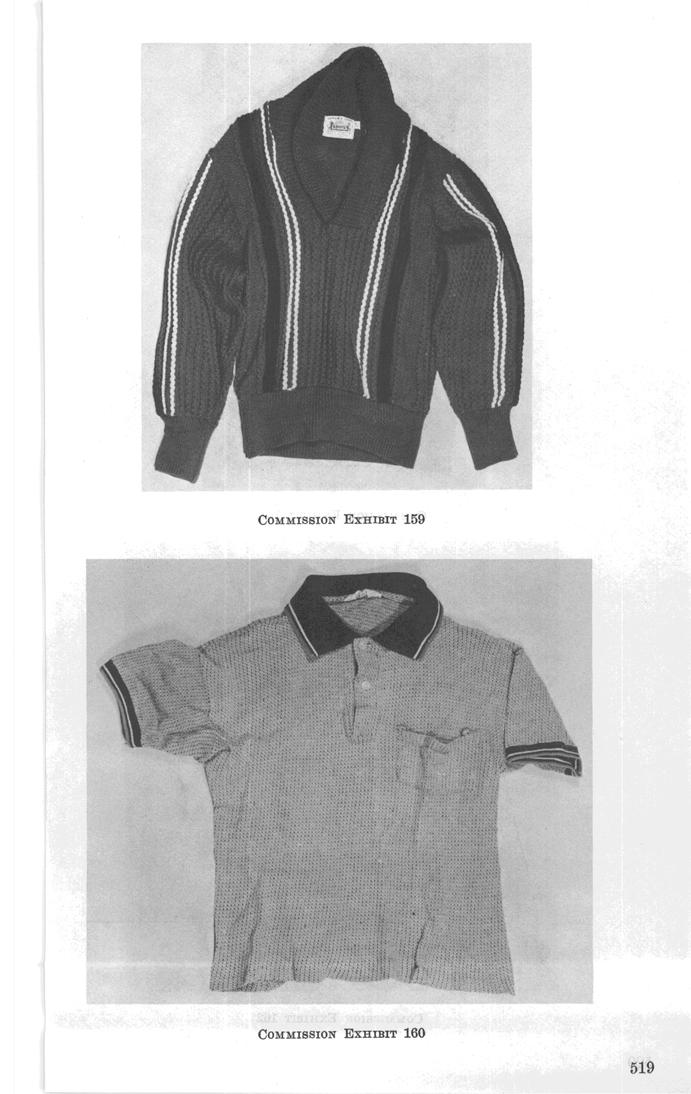 |
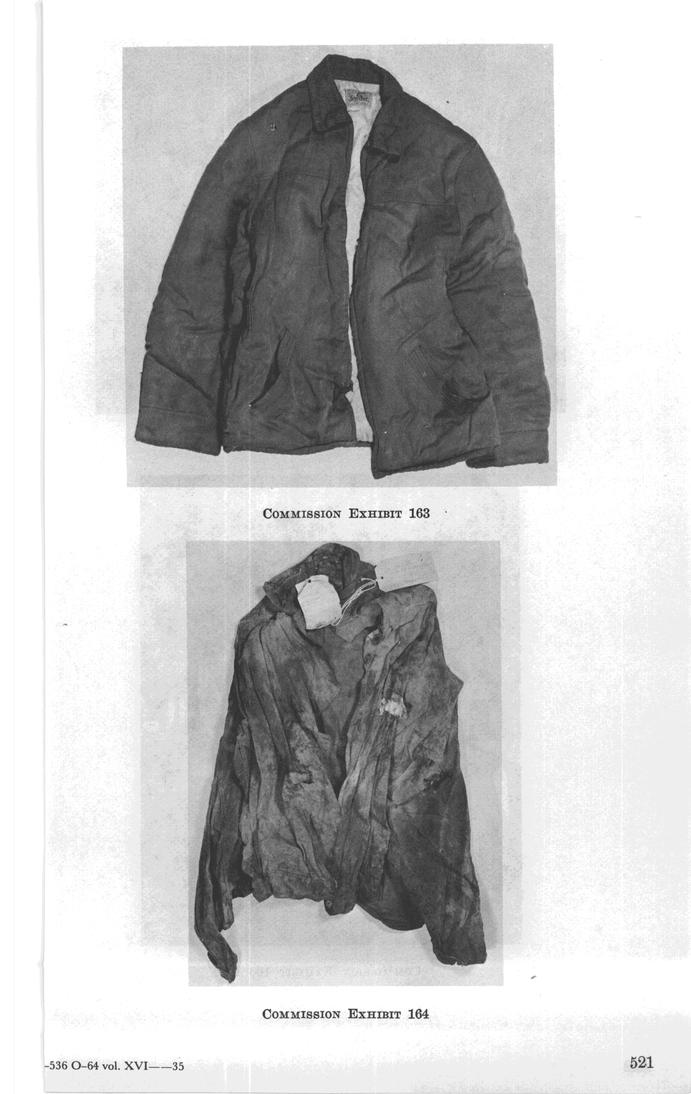 |
(HARVEY) Oswald
owned only one long-sleeved shirt with a button down collar--a light
brown shirt (CE 152), which was one of the items found in Oswald's
room and inventoried by Det Fay M. Turner. When
searching Oswald's room Dets. Turner and Senkel took everything out
of his small dresser, everything in his small room, and threw it on
the bed. They wrapped the bed sheet around Oswald's belongings,
took the bundle of items to their car, and then drove to police
headquarters where they inventoried and photographed the items. Two
of the items inventoried were listed as a "brown
shirt with button down collar" and "one pair of
grey trousers and other miscellaneous man's
clothing.”
Mary Bledsoe, Milton Jones, and
William Whaley all said that (HARVEY) Oswald was wearing a dark brown,
long-sleeved shirt. And it appears that Dallas Police officer Marrion
Baker saw Oswald wearing this same shirt when he confronted him in the
2nd floor lunchroom at the TSBD.
Mr. Belin. Handing you what has been marked as Commission Exhibit 150, would this appear to be anything that you have ever seen before?
Mr. Baker. Yes, sir; I believe that is the shirt that he had on when he came. I wouldn't be sure of that. It seemed to me like that other shirt was a little bit darker than that whenever I saw him in the homicide office there.
Officer Baker, who saw (HARVEY) Oswald for only a few seconds, thought that Oswald may have been wearing a jacket (instead of a long-sleeve shirt). Oswald's dark brown shirt, with no button down collar, missing 3 or 4 buttons on the top of the shirt placket, and with two buttons on the lower portion of the shirt placket, may have looked like a jacket to Baker, as it did to other witnesses.
Witnesses Marrion Baker, Mary Bledsoe, Roy Milton Jones, and William Whaley saw Oswald wearing a dark brown long-sleeved shirt. Oswald was arrested wearing a dark brown long-sleeved shirt. Oswald owned only one, dark brown long-sleeved shirt. Therefore, it is almost certain that Oswald wore this dark brown long-sleeved shirt to work, in the bus, in the taxi, in his room (he changed only his t-shirt), in the theater, and at the police station. The bus transfer that Oswald put in the shirt pocket of his dark brown long-sleeved shirt was found by Det. Sims in the same shirt.
US Marshall Robert Nash asked Oswald about his religious views, and he replied that he didn't agree with all the philosophies on religion. He seemed evasive with inspector Kelley about how he felt about religion, and I asked him if he believed in a Deity. Oswald was evasive and didn't answer this question.
WC attorney Mr. Joseph Ball (to William Whaley): Later that day did you-were you called down to the police department?
Mr. Whaley: No. sir; they came and got me, sir, the next day after I told my superior when I saw in the paper his picture, I told my superiors that that had been my passenger that day at noon. They called up the police and they came up and got me....They took me in an office there and I think Bill Alexander, the Assistant District Attorney, two or three, I was introduced to two or three who were FBI men and they wanted my deposition of what happened. So I told them to the best of my ability....I made this statement to Bill Alexander, because I tried to talk to him more. Everybody was trying to talk to me at once. They were writing it out on paper, and they wrote it out on paper, and this officer, Leavelle, I think that is his name, before he finished and before I signed he wanted me to go with him to the lineup, so I went to the lineup....”
In
Whaley's affidavit, which
he signed one day after transporting (HARVEY) Oswald for only a few
minutes in his taxi,
he said, “This boy was small, five feet eight inches, slender, had
on a dark shirt with white spots of something on it. He had a
bracelet on his left wrist. He looked like he was 25 or 26 years
old. At approximately 2:15 PM this afternoon I viewed a line up of 4
men in this City Hall. The
number 3 man who I now know as Lee HARVEY Oswald was the man who I
carried from the Greyhound Bus Station to the 500 block of North
Beckley.”
Whaley told the WC, “Then they took me down in their room where they have their show-ups, and all, and me and this other taxi driver who was with me [Scoggins], sir, we sat in the room awhile and directly they brought in six men, young teenagers, and they all were handcuffed together. Well, they wanted me to pick out my passenger....you could have picked him out without identifying him by just listening to him because he was bawling out the policeman, telling them it wasn't right to put him in line with these teenagers and all of that and they asked me which one and I told them. It was him all right, the same man.”
Mr. Belin. Now, your affidavit which is Whaley's Deposition Exhibit A, the last sentence says, “The No. 3 man who I now know as Oswald was the man who I carried from the Greyhound bus station to the 500 block of North Beckley.” Now you say it was the No. 2 man from your left, is that correct?
Mr. Belin. Do you remember now whether the man that you saw there was the No. 2 or the No. 3 man?
Mr. Whaley. I will admit he was No. 2
Mr. Belin. No. 2 from your left, or from your right?
Mr. Whaley. He was the third man out in the line of four as they walked out in a line. They put the first man out on the right, and the last one on my left, and as near as I can remember, he was No. 2, but it was the man I hauled.
Mr. Belin. It says here the No. 3.
Mr. Whaley. Yes, sir; but I meant that he was the third one out when they walked out with him. I said from my right.
Whaley. I saw the picture in the paper when they had, when Ruby killed him at the time between the two detectives.
Mr. Belin. Was that the same man you carried in your cab on Friday?
Mr. Whaley. Yes, sir.
Mr. Belin. Was that the man you identified at the police station?
Mr. Whaley: Yes, sir….I come back and he asked me which one it was, which number it was, and I identified the man, and we went back up in the office again, and they had me sign this.
Mr.
Ball. Now, when you signed it....did they have any statements on
there before you went down to the lineup.
William
Whaley
remembered his passengers height, approximate weight, dark brown
shirt, grey trousers, and the silver colored stretch band bracelet
of the man who got into his taxi for a mere 6 minute ride to Oak
Cliff. Whaley remembered the blond-haired woman who asked him to call a
taxi. He remembered that his passenger told him to drive to the
500 Block of N. Beckley. He remembered the taxi fare was 95 cents.
He remembered that his passenger got out of the taxi, walked in
front of the taxi and crossed the street. Whaley identified Oswald as
his passenger from the police lineup. Whaley seems to have a good,
though not perfect, memory. It should be remembered that even though
Whaley sat beside his passenger for about six minutes, he was driving a
taxi and probably saw Oswald's face only when his
passenger entered and left the taxi. Whaley should be commended for
being able to remember and describe anything about one of thirty
passengers he carried that day. There is no indication that Whaley
was coerced or pressured to identify Harvey Oswald as his passenger.
Under the hectic circumstances that surrounded William
Whaley's visit to police headquarters on 11/23/63, Mr. Whaley did the
best he could.
12 Hours of Interrogation
(HARVEY) Oswald was interrogated for 12 hours in the presence of a dozen or more law enforcement officers. He was asked again and again how he got to his rooming house. He was paraded in lineups before bus driver Cecil McWatters and taxi driver William Whaley. He was questioned about the bus transfer, and talked about the lady who asked Whaley to call her a taxi. The WC interviewed McWatters, Whaley, and two witnesses who saw and remembered Oswald on the bus. They reviewed taxi driver Whaley's trip manifest and even rode in his taxi to determine the amount of time it took to drive from the Greyhound Bus station to Oswald's rooming house.
But during 12 hours of questioning there is no record that Capt. Fritz and a dozen or more law enforcement officers, nor any of the WC attorneys, asked Oswald how he got from his rooming house to the Texas Theater. Oswald's method of transportation to the theater remains unknown. Earlene Roberts last saw Oswald at 1:03 PM, standing near the corner of Zang and Beckley. Texas Theater employee Butch Burroughs said that Oswald was at the theater by 1:07 PM. It is obvious that (HARVEY) Oswald had to have ridden a bus/taxi to the theater or was driven by car. If he rode in a bus or taxi, then why would he not freely admit this to Capt. Fritz during interrogation? And, if he did, then why would the bus driver, bus passengers, and/or a taxi driver not remember Oswald from photographs in the newspaper on 11/22/63 and notified the police?
If (HARVEY) Oswald was driven to the
theater by Officer Tippit, or persons unknown (Capt. W.R. Westbrook
& Sgt. Kenneth Croy), this could explain his silence. But it does
not explain why his interrogators failed to ask, and record in their
notes or their reports or during WC testimony, how he got to the
theater. They questioned him at length concerning the bus and taxi
ride, yet there is nothing to indicate that his interrogators asked him
a single question about how he got to the theater. Or did they? It
is far more likely the police asked Oswald these questions and he
either told them the truth, or he refused to answer. Either way, these
law enforcement officers didn't write down anything about how Oswald
got from his rooming house to the theater. Nor did they write down
anything related to their asking Oswald about the murder of Officer
Tippit. Are we to assume that each and every one of these law
enforcement officers forgot to ask Oswald about Tippit's murder?
Following the assassination, the Dallas police made a house to house
search in an attempt to find witnesses who saw Oswald walking from his
rooming house to 10th & Patton and to the Texas Theater. Their
results were negative. Another indication that (HARVEY) Oswald was
driven to the theater.
![]()
III. NAYSAYERS
There are some people who believe the bus ride never happened, and that the entire story of the bus ride was fabricated. In order to reach their conclusions these people focus attention on witnesses whose memories are less than perfect, and then continuously criticize these people in an attempt to destroy their credibility. These people often misread witness statements and testimony. They criticize documents without thoroughly understanding what they are reading. Their cited "sources" are often not sources at all and, in some cases, are non-existent. They (naysayers) do this in an attempt to develop and promote their own preconceived ideas and theories. However, when their work is closely scrutinized, it becomes apparent that many of these naysayers have not done their homework. For example:
Naysayers criticize bus driver Cecil McWatters because he could not positively identify (HARVEY) Oswald as a passenger on his bus. Naysayers ignore McWatters' description of this one passenger and his clothing—a man who rode in the middle of the bus for only 4 minutes. These naysayers forget there were perhaps dozens of bus passengers on several of McWatters' bus runs on 11/22/63, yet they endlessly criticize him for not remembering details about this one passenger.
Naysayers criticize the testimony and memory of Milton Jones, who remembered Oswald as a passenger and remembered his light blue jacket and grey pants. Naysayers conveniently forget that Oswald sat behind Jones, and only saw Oswald for a few seconds when he boarded and got off McWatters' bus.
Naysayers criticize the testimony and memory of Oswald's former landlady Mary Bledsoe, who described Oswalds dark brown shirt, the hole in the sleeve, and the missing buttons very well. Naysayers believe that Oswald changed the shirt he wore to work at his rooming house before he went to the theater, relying on the reports of Kelley and Bookhout. Therefore, naysayers criticize Bledsoe because her description of the shirt matches the shirt Oswald was wearing at the theater when arrested.
Naysayers
claim that Oswald changed his shirt at his rooming house, citing the
reports of Kelley and Bookhout, who wrote that Oswald removed a reddish-colored, long-sleeved shirt with a
button down collar and placed it in the lower drawer of his dresser.
The problem with their reports is that Oswald did not own a reddish-colored,
long-sleeved shirt with a
button down collar. He did own one, and only one,
reddish-brown shirt, but this shirt
did not have a button down collar (CE 150)
and this was the shirt Oswald was wearing when arrested in the Texas
Theater. All of Oswald shirts were listed in DPD inventory. In the
Warren Volumes these shirts are photographed and identified as WC #150
&
151 & 152-all long sleeved, and not one shirt is reddish-colored, long-sleeved, with a
button down collar. WC # 153 & 154 & 155 & 160 are
all short sleeved shirts. Oswald could not have removed a reddish-colored, long-sleeved shirt with
a button down collar, because
he didn't own such a shirt.
Oswald did remove one shirt and put it in his dresser drawer, as he
told Capt. Fritz. This was his dirty white t-shirt, soiled around the
collar.
Naysayers criticize Mary Bledsoe and say that she did not see Oswald on the bus, because she saw “only a glimpse of him.” Naysayers forget that Oswald rented one of 3 bedrooms in her home and she saw him on a daily basis only 5 weeks before the assassination. He talked on the telephone constantly and interrupted her naps. Mrs. Bledsoe remembered that Oswald often spoke in a foreign language on her telephone. She was very familiar with Oswald's face and physique. Mrs. Bledsoe only needed a “glimpse” of (HARVEY) Oswald to recognize him instantly.
Naysayers constantly criticize Bledsoe and Jones and Whaley for their less than perfect memories. But Oswald was only in their presence for a mere 4-6 minutes. Naysayers conveniently forget that Bledsoe and Jones and Whaley all remembered that Oswald wore light colored grey pants on the bus and taxi. Oswald told Capt. Fritz that he had changed his dirty trousers (light colored grey pants) in his room. When arrested, Oswald was wearing very dark pants. His dirty light colored grey pants were later found in his room by police. How could Bledsoe and Jones and Whaley have known Oswald was wearing light grey pants on the bus/taxi unless they had personally seen him?
Naysayers claim that McWatters never gave Oswald a bus transfer. If McWatters never gave bus transfer #004459 to Oswald, then perhaps naysayers would care to explain why Dallas Police called the Dallas Transit Division Superintendent. Explain how Mr. F.F. Yates was able to immediately identify McWatters as the driver who issued the bus transfer. Do the naysayers expect us to believe that Dallas Transit supervisors were coerced into going along with a fabricated story that the bus ride never happened?
Naysayers ignore the fact that transfer #004459 came from McWatters' transfer book. They ignore McWatters' testimony that he remembered giving a transfer to Oswald and a transfer to a blond haired lady when both were getting off the bus. Naysayers ignore Mary Bledsoe's testimony that she spoke briefly with the blond lady when McWatters gave her a transfer. How would Oswald know about a blond-haired lady on McWatters bus unless he had ridden on that bus?
Naysayers claim the bus transfer at the National Archives does not have a crease in the middle, so it was never folded and put in Oswald's pocket. Naysayers ignore the fact that National Archivist Steve Hamilton confirmed that the bus transfer has a crease in the middle, indicating that it had at one time been folded.
Naysayers question the number of transfers given out by McWatters on 11/22/63. They know the first transfer McWatters issued was #004452, and they know the police found transfer #004459 in Oswald's shirt pocket. They claim, correctly, that McWatters gave out 8 transfers (#004452 to #004459). But they then claim that because McWatters told the WC that he gave out only two transfers, that 6 transfers were “missing.” Once again, these naysayers are simply misreading testimony. McWatters told the WC, “Yes, sir; I gave him one [bus transfer] about two blocks from where he got on [at Griffin]...that is the transfer because it had my punch mark on it....I gave only two transfers going through town on that trip [going through town on that trip!] and that was at the one stop of where I gave the lady and the gentlemen that got off the bus, I issued two transfers....But that was the only two transfers were issued [on that ONE trip thru town]. Very simple. McWatters issued six transfers prior to picking up Oswald and the blond lady (prior to 12:40 PM). He then issued a transfer to the blond lady and a transfer to Oswald when they got off the bus (circa 12:44 PM).
Oswald told Capt. Fritz and his interrogators about a blond woman asking William Whaley to call her a taxi, just after Oswald got into Whaley's taxi. William Whaley told the WC the same story--that just after Oswald got into the front seat of his taxi, a blond lady asked him to call a taxi for her. How is it possible that Oswald's and Whaley's stories match perfectly, unless the taxi ride acutally happened and was remembered by both Oswald and Whaley?
Naysayers conveniently forget that Oswald's reference to a blond-haired lady, which he told to Capt. Fritz and numerous law enforcement officers during interrogations, was also remembered by Cecil McWatters, Mary Bledsoe, and Roy Milton Jones.
Naysayers criticize William Whaley for saying that Oswald had a silverlike strip on his shirt. Naysayers ignore and intentionally overlook that Whaley also said Oswald was wearing a brown long-sleeve shirt and a t-shirt with a soiled collar.
Naysayers criticize William Whaley because he said Oswald's bracelet was a “stretchband,” when it looks like a “chain link” bracelet. But naysayers, once again, should do their homework. Oswald's bracelet is listed on a DPD property form, found in Box 1, folder 8, item 1 at the Dallas Archives. It is identified as "One I.D. stretch band with 'Lee' inscribed.” Naysayers also fail so explain how Whaley could have known that Oswald was wearing any kind of silver-colored bracelet, unless he saw the bracelet himself on Oswald's left arm while riding in his taxi.
Naysayers criticize William Whaley when he said that he drove Oswald to Neches and Beckley, because this address is non-existent. Naysayers conveniently fail to remember that Oswald instructed Whaley to drive to the 500 block of N. Beckley. As Whaley was driving south on N. Beckley, Oswald said “this will do.” Whaley then stopped randomly in the street, at an unknown address, and Oswald got out of his taxi. Whaley wrote “500 N. Beckley” in his manifest because that is what he remembered Oswald told him when he first got into his taxi.
Naysayers criticize William Whaley because he wrote down the time of Oswald's taxi ride incorrectly in his manifest. Naysayers conveniently forget that Whaley explained to the WC that he always wrote the times of his taxi rides in 15-minute intervals. And said that he often wrote two, three, or four of these entries in his manifest at the same time, long after the taxi rides. Whaley said that when he got back to the Union Terminal he made an entry of the trip (to N Beckley) on his manifest for the day.
Naysayers criticize taxi driver William Whaley for naming the number 3 man in the police lineup as Oswald, when he was identified by the police as the number 2 man. Naysayers ignore the explanation that Whaley gave to the WC. Whaley simply said that LHO, walking from left to the right, was the 3rd man brought out for the lineup. From left to right, according to the police, Oswald was the #2 man.
Naysayers criticize and criticize these witnesses over the smallest of details, in an attempt to “prove” that the bus and taxi ride never happened. This is the extent of their “research.”
Naysayers ignore the fact that Capt. Fritz and many law enforcement officers heard Oswald say that he rode a bus, got a bus transfer, got into a taxi, offered to let a blond-haired lady have his taxi, and paid an 85 cent fare. The facts are that Mary Bledsoe and Roy Milton Jones testified that Oswald was on McWatters bus, transfer #004459 was found in Oswald's shirt pocket, William Whaley testified that Oswald rode in his taxi, that Oswald offered to let a blond-haired lady have his taxi, and that Oswald paid 95 cents in taxi fare. Witness testimony and evidence match pretty well with what Oswald told his interrogators.
Naysayers criticize, criticize, and criticize these witnesses for not having perfect memories. Yet these naysayers never produce a single document or a single witness by which to prove the taxi and bus ride never happened. Nor can they offer an ounce of PROOF as to what they think COULD HAVE happened—only speculation, fantasies, and daydreams.
To these naysayers, I would ask them to simply identify the person or persons who came up with the idea to fabricate a story in which the bus and taxi rider never happened. I would ask them to name the person or persons who had the knowledge, presence, and ability to fabricate such a hoax within hours of Oswald's arrest..
I would remind naysayers that Oswald himself said during his first and second interrogations that he rode a bus, long before the police knew about Cecil McWatters. And Oswald made these statements in the presence of Capt. Fritz, James Hosty, Thomas Kelley, James Bookhout, and numerous officers. These people took notes, made reports, and/or gave WC testimony about statements made by Oswald. These naysayers would have us believe that a person or persons unknown convinced all of these people (SS agents Kelley, Nully and Forrest: FBI agents Hosty, Grant, Odum and Bookout; US Marshall Nash; Capt Fritz, DPD officers Sims, Boyd, Turner, Hall, Dhority, Owens, Leavelle, and Senkel, taxi driver Whaley, bus driver McWatters, bus passengers Bledsoe and Jones, bus and taxi officials) to lie and go along with a fabricated story that the bus and taxi ride never happened. But no matter how much evidence researchers produce to prove that Oswald rode on a bus and in a taxi on 11/22/63, we can be sure that irresponsible naysayers can and will find the most trivial, superficial, and inconsequential reasons to continue their criticism.
Rather than nit-pick the statements and memories of witnesses who saw “Lee Harvey Oswald” riding in either the station wagon, bus, or taxi, naysayers should study the overwhelming amount of evidence that shows there were two “Lee Harvey Oswalds” who looked very similar. At 12:40 PM LEE Oswald got into a Nash Rambler station wagon in front of the TSBD, while HARVEY Oswald was getting into McWatters' city bus at Elm and Griffin. An hour and a half later HARVEY Oswald was arrested, handcuffed, and sitting in a room at Dallas Police headquarters. When Capt Fritz pointed to Roger Craig and said to Oswald, “This man saw you leave....what about the car?” Oswald replied, “that station wagon belongs to Mrs. Paine.....” HARVEY Oswald dared not say any more, but his statement about Mrs. Paine and a station wagon shows that he knew a lot more than what he told his interrogators .
George Lardner, of
the Washington Post,
reported that “[CIA Director] Richard Helms told reporters that no one
would ever know who or what Lee Harvey Oswald...represented.” In 1977
Helms became the only CIA director to be convicted of misleading
Congress.
![]()